#he's particularly inspired by Caravaggio
Note
Hi, are you aware of a contemporary Italian artist called Roberto Ferri, who specialises in surreal, horrific art in the style of the Baroque masters? Seems like a very Machete vibe.
TW: Baroque nudity.
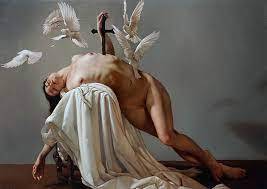



Oh, definitely, I've been admiring his work for years! I love the otherworldy atmosphere of his pieces, and his sense of anatomy never ceases to amaze me. He makes his subjects seem so tangible and fleshy.

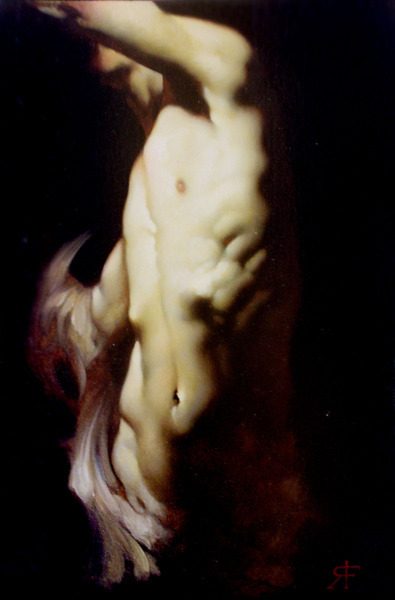







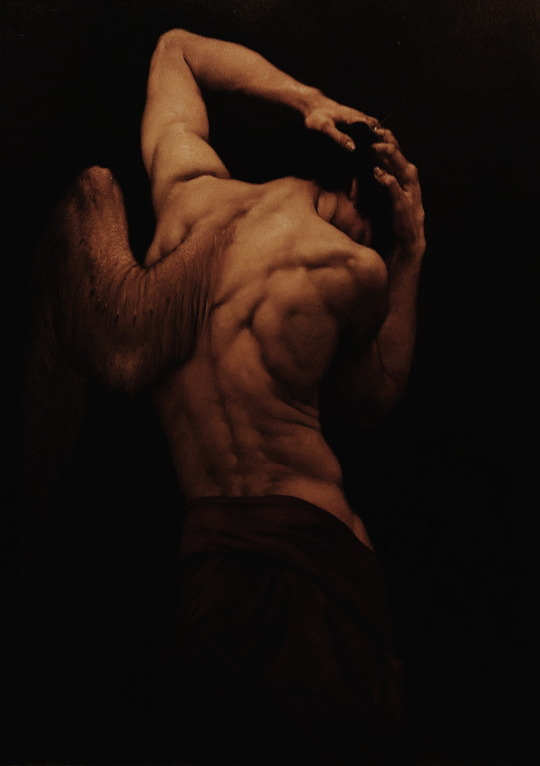

This specific underarm grab lives in my head.

#he's fairly active on instagram (@robertoferri_official) and I see his work there whenever I check in every two weeks or so#he's particularly inspired by Caravaggio#who is canonically Machete's favorite artist and his contemporary#so a lot of the vibes match#answered#kinsey3furry300#cw nudity#nudity#long post
920 notes
·
View notes
Text
slow inhale
Inverted crosses and crucifixes are not “iconic symbols of Satanism”!!!

The above image? 100% holy. Totally canonical. Has absolutely NOTHING to do with Satan, Lucifer, or “The Devil”. It’s called the Petrine Cross aka The Cross of Saint Peter and is a symbol of piety, humility, deference, and martyrdom particularly to Jesus Christ (not necessarily his other canonical phases of existence) and his relationship with the Pope. It’s also one of the symbols most closely associated with The Pope.
It is one of the main reasons I can’t take exorcist and demon-themed horror movies seriously ever. Not because I’m a polytheistic soul-selling Bandrui (those things are true but they’re not why), but because it’s a continuity error! A hilarious one if you think about it! The demon is just showing how much the characters really don’t understand about the religion they’re espousing in the movie!
So, why would St. Peter be associated with something that, for all intents and purposes, we visually associate with something that is backwards from Christianity or whatever “holiness” means? Because, like Jesus, St. Peter was also crucified, or at least that is the version of St. Peter’s story that is considered most canonical. In truth, stories about St. Peter that still exist date back only as late as 200 AD with the apocryphal “Acts of Peter”. Whether or not the upside down part of the story was canonical hasn’t been determined with any real certainty, but it was the version told by this guy:

Origen of Alexandria! Origen was largely considered one of the greatest early Christian luminaries, scholars, philosophers, poets, and all-around book nerds and is the primary source for the whole “St. Peter was crucified upside down” story, inspiring Renaissance masterworks like this little number by Caravaggio:

“Crucifixion Of Saint Peter”
Origen’s popularized telling of the tragic demise of St. Peter makes a big deal about the story-canonical feature that St. Peter insisted upon being crucified upside-down because he didn’t feel worthy to emulate the same, now-iconic crucifixion of Jesus.
So how did the Petrine Cross become a symbol associated with Satanism?
France.
Well, not all of it, but France was involved. In the early 19th century, a cult leader by the name of Eugène Vintras insisted that he was the reincarnation of the Prophet Elijah. Aside from that, he also practiced necromancy (which is the art of cavorting with DEMONS, not corpses for the love of my blackened, shriveled occultist heart) and was commonly seen wearing robes and symbols depicting the Petrine Cross.
In comes This Guy:
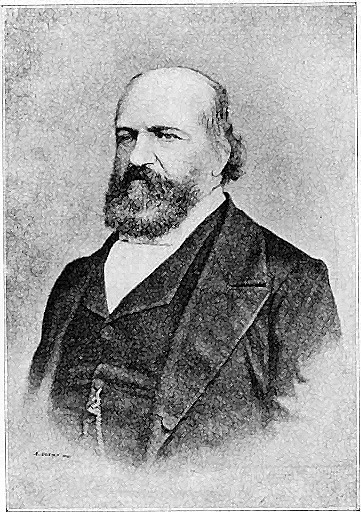
Éliphas Lévi was another famous 19th century French Occultist (after leaving the Catholic priesthood when he was in his 20′s to get drunk and listen to metal or something) who took one look at, and presumably all surviving sketches of Eugène Vintras, saw his regalia of Petrine crosses, and wrote the literally-damning words that for wearing his inverted crosses, Vintras’ satanic leanings were obvious.
After Éliphas Lévi wrote about Vintras’ wearing of the Petrine Cross and Satanic preferences, the inverted cross gradually became more and more associated with anti-religion movements and, of course, Satanism. The final nail in the Apocryphal Iconography Crucifixion came in the 1960′s-1980′s with the dawn of the horror movie franchise and the rise of the Satanic Panic, a mass hysteria movement that had to be debunked by the FBI where young people and children were convinced by their therapists during hypnotherapy sessions that they had been the subjects of Satanic rituals at the hands of the parents/guardians at very young ages that never happened, destroyed families, left countless people traumatized. FBI agent Kenneth Lanning went on to publish what’s commonly referred to as “The Lanning Report” to debunk the claims of abuse and lambast the therapist that started the panic in the first place.
If you want to really rock like a Satanist, consider donating stuff like feminine hygiene products to your local Planned Parenthood ;)

#inverted cross#petrine cross#catholic history#occult history#satanic panic#occultism#catholicism#satanism#menstruatin with satan
53 notes
·
View notes
Text
SAINT OF THE DAY (September 21)
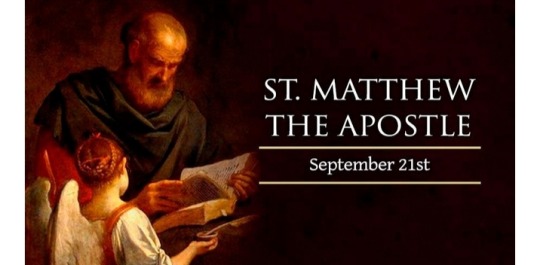
Saint Matthew, the first-century tax collector turned apostle who chronicled the life and ministry of Christ in his Gospel, is celebrated by the Church today, September 21.
Although relatively little is known about the life of St. Matthew, the account he wrote of Christ's ministry — traditionally considered to be the first of the four Gospels — is of inestimable value to the Church, particularly in its verification of Jesus as the Messiah.
Eastern Catholics and the Orthodox churches celebrate St. Matthew on November 16, along with St. Fulvianus, a prince who is recorded in some traditions as converting from paganism after Matthew's martyrdom.
The Gospel accounts of Mark and Luke, like Matthew's own, describe the encounter between Jesus and Matthew under the surprising circumstances of Matthew's tax-collecting duties.
Jewish publicans, who collected taxes on behalf of the Roman rulers of first-century Judea, were objects of scorn and even hatred among their own communities, since they worked on behalf of the occupying power and often earned their living by collecting more than the state's due.
Jesus most likely first encountered Matthew near the house of Peter, in Capernaum near the Sea of Galilee.
The meeting of the two was dramatic, as Matthew's third-person account in his Gospel captured:
“As Jesus passed on,” the ninth chapter recounts, “he saw a man named Matthew sitting at the customs post. He said to him, 'Follow me'. And he got up and followed him.”
Matthew's calling into Jesus' inner circle was a dramatic gesture of the Messiah's universal message and mission, causing some religious authorities of the Jewish community to wonder:
“Why does your teacher eat with tax collectors and sinners?”
Jesus' significant response indicated a central purpose of his ministry: “I did not come to call the righteous but sinners."
A witness to Christ's resurrection after death, as well as his ascension into heaven and the events of Pentecost, Matthew also recorded Jesus' instruction for the apostles to “go, therefore, and make disciples of all nations, baptizing them in the name of the Father, and of the Son, and of the holy Spirit, teaching them to observe all that I have commanded you.”
Like 11 of the 12 apostles, St. Matthew is traditionally thought to have died as a martyr while preaching the Gospel.
The Roman Martyrology describes his death as occurring in a territory near present-day Egypt.
Both the saint himself and his Gospel narrative have inspired important works of religious art, ranging from the ornate illuminated pages of the Book of Kells in the ninth century, to the Saint Matthew Passion of J.S. Bach.
Three famous paintings of Caravaggio, depicting St. Matthew's calling, inspiration and martyrdom, hang within the Contarelli Chapel in Rome's Church of St. Louis of the French.
Reflecting on St. Matthew's calling, from the pursuit of dishonest financial gain to the heights of holiness and divine inspiration, Pope Benedict said in 2006:
“In the figure of Matthew, the Gospels present to us a true and proper paradox: those who seem to be the farthest from holiness can even become a model of the acceptance of God's mercy and offer a glimpse of its marvelous effects in their own lives.”
6 notes
·
View notes
Text
Top 20 Painters of All Time:
1. Leonardo da Vinci (1452–1519)
• An Italian polymath of the Renaissance, best known for his iconic works “Mona Lisa” and “The Last Supper.” Leonardo’s notebooks, filled with scientific diagrams, anatomical sketches, and artistic innovations, reveal his genius and insatiable curiosity.
2. Vincent van Gogh (1853–1890)
• A Dutch post-impressionist painter whose work, notable for its beauty, emotion, and color, highly influenced 20th-century art. He struggled with mental illness and remained largely unappreciated during his lifetime. “Starry Night” and “Sunflowers” are among his most famous works.
3. Pablo Picasso (1881–1973)
• A Spanish painter, sculptor, and one of the most influential artists of the 20th century. He co-founded the Cubist movement and is known for works like “Guernica” and “Les Demoiselles d’Avignon.”
4. Michelangelo Buonarroti (1475–1564)
• An Italian sculptor, painter, architect, and poet of the High Renaissance, celebrated for the painting of the Sistine Chapel ceiling and his sculpture “David.” His work is admired for its detailed portrayal of the human body.
5. Claude Monet (1840–1926)
• A French painter, a founder of French Impressionist painting, and the most consistent and prolific practitioner of the movement’s philosophy. His “Water Lilies” series is particularly famous.
6. Rembrandt van Rijn (1606–1669)
• A Dutch draughtsman, painter, and printmaker. Considered one of the greatest visual artists in the history of art and the most important in Dutch art history. His works include portraits, self-portraits, and biblical scenes.
7. Johannes Vermeer (1632–1675)
• A Dutch painter who specialized in domestic interior scenes of middle-class life. Vermeer was a moderately successful provincial genre painter in his lifetime but is now highly regarded for his precise compositions and use of light, notably in “Girl with a Pearl Earring.”
8. Salvador Dalí (1904–1989)
• A Spanish surrealist artist known for his striking and bizarre images. Dalí’s expansive artistic repertoire includes film, sculpture, and photography, in collaboration with a range of artists in a variety of media.
9. Frida Kahlo (1907–1954)
• A Mexican painter known for her many portraits, self-portraits, and works inspired by the nature and artifacts of Mexico. Her work has been celebrated internationally as emblematic of Mexican national and Indigenous traditions.
10. Georgia O’Keeffe (1887–1986)
• An American artist best known for her paintings of enlarged flowers, New York skyscrapers, and New Mexico landscapes. O’Keeffe has been recognized as the “Mother of American modernism.”
11. Jackson Pollock (1912–1956)
• An American painter and a major figure in the abstract expressionist movement. He was well known for his unique style of drip painting.
12. Edvard Munch (1863–1944)
• A Norwegian painter and printmaker whose intensely evocative treatment of psychological themes built upon some of the main tenets of late 19th-century Symbolism and greatly influenced German Expressionism in the early 20th century. His best-known work is “The Scream.”
13. Raphael (1483–1520)
• An Italian painter and architect of the High Renaissance. His work is admired for its clarity of form, ease of composition, and visual achievement of the Neoplatonic ideal of human grandeur. Known for “The School of Athens.”
14. Caravaggio (1571–1610)
• An Italian painter known for his realistic observation of the human state, both physical and emotional, which had a formative influence on Baroque painting. His use of dramatic lighting and realism was groundbreaking.
15. Titian (c. 1488/90–1576)
• An Italian painter, the most important member of the 16th-century Venetian school. He was recognized early in his own lifetime as a supremely talented painter, and his work was influential in defining the Venetian Renaissance.
16. Gustav Klimt (1862–1918)
• An Austrian symbolist painter and one of the most prominent members of the Vienna Secession movement. Klimt is noted for his paintings, murals, sketches, and other objets d’art. “The Kiss” (1907–1908) is his most famous work.
17. Hieronymus Bosch (c. 1450–1516)
• An Early Netherlandish painter known for his surreal, imaginative works depicting religious concepts, moral allegories, and narratives filled with fantastical creatures. “The Garden of Earthly Delights” is his most famous work.
18. Paul Cézanne (1839–1906)
• A French artist and Post-Impressionist painter whose work laid the foundations of the transition from the 19th-century conception of artistic endeavor to a new and radically different world of art in the 20th century.
19. Wassily Kandinsky (1866–1944)
• A Russian painter and art theorist credited with painting one of the first recognized purely abstract works. He believed that art could visually express musical compositions.
20. Andy Warhol (1928–1987)
• An American artist, film director, and producer who was a leading figure in the visual art movement known as pop art. His works explore the relationship between artistic expression, culture, and advertisement.
Each of these artists contributed uniquely to the fabric of art history, influencing not only their contemporaries but also countless artists and enthusiasts who followed.
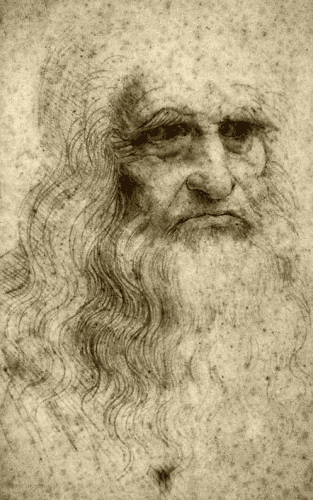
0 notes
Text
Assignment #9 - Caravaggio
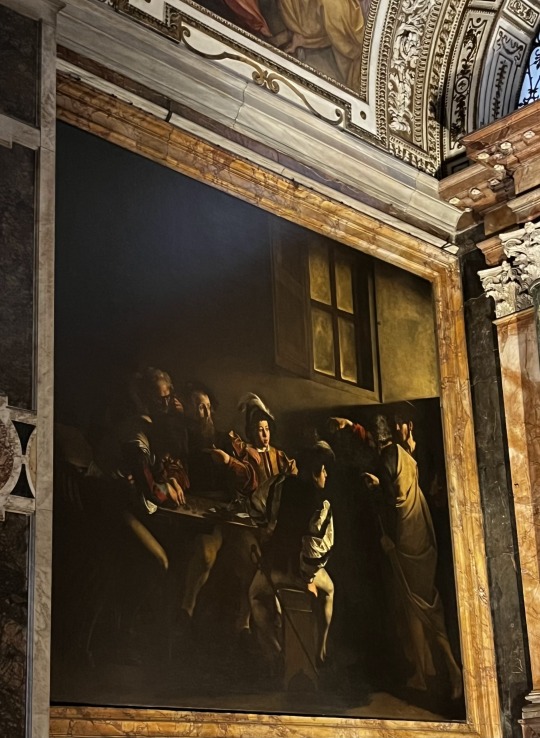
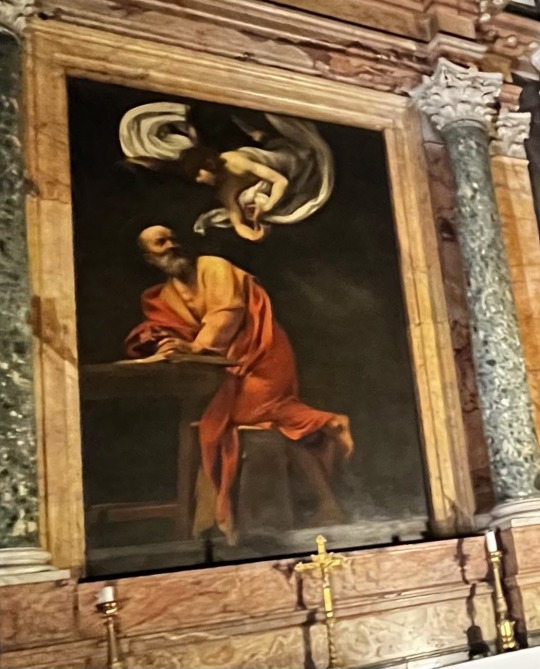

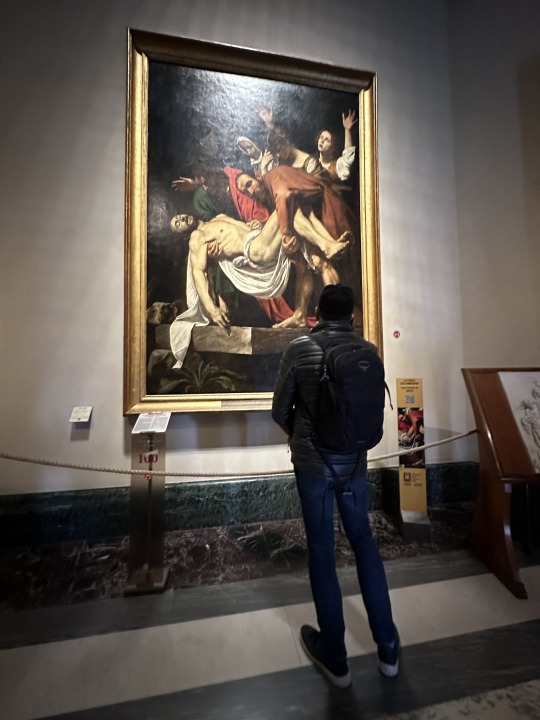
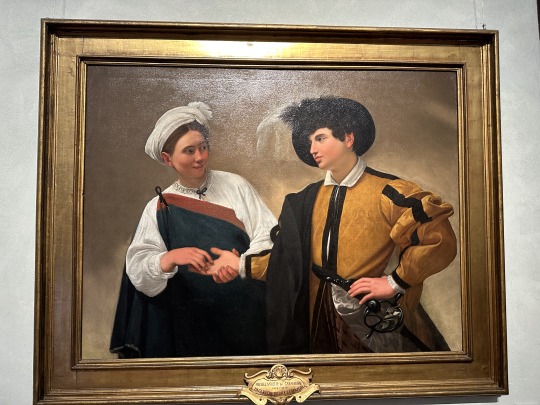
Find and photograph any ten Caravaggio paintings in Rome:
Briefly describe the content of each paintings. Also, what is the most brightly painted object in each of the paintings? Use one (or more) of the Caravaggio paintings that you discovered in Rome to respond to Michael Fried’s account of absorption (in the Soundcloud lecture). Set out Fried’s account and then how the painting does or does not fit his account.
The Calling of St Matthew: This painting depicts the moment when Jesus calls Matthew, a tax collector, to become one of his disciples. Caravaggio's portrayal often emphasizes the transformative moment of Matthew's conversion. The brightly painted piece of the painting is the beam of light that illuminates the faces of the men at the table who are looking at Jesus Christ.
The Inspiration of Saint Matthew: In this artwork, Caravaggio portrays the divine inspiration of Saint Matthew as he is writing the Gospel. The painting captures a moment of spiritual revelation. All is darkness but for the two large figures
The Martyrdom of Saint Matthew: This painting depicts the martyrdom (death) of Saint Matthew, one of the twelve apostles of Jesus. It typically shows the moment when Saint Matthew is killed for his faith. The brightest piece of the artwork is the saint being murdered by a soldier. However, I posit that the centerpiece is not the saint, but the soldier. Being at the center of the painting and being seminude, the whiteness of the soldier's skills draws the viewer's gaze.
The Entombment of Christ: Caravaggio's "The Entombment of Christ" portrays the burial of Jesus Christ after his crucifixion. The composition often includes figures mourning the death of Christ. With a clean white robe and his white skin, Jesus is the brightest entity within the painting. However, in the emersion of the painting, you may catch a glimpse of a man. That very man with who's very face is unseen. Instead, you are devoided with an identity left missing. You are left to look within and only guess his lore. Is that a man from the local hipster wine bar? Is that a man with a doctorate degree in Political Science? Is he a professor at a university located in the Washington Metropolitan area? Or worst of all, is he a Green Day fan?
The Fortune Teller: "The Fortune Teller" depicts a scene where a young man is having his palm read by a gypsy fortune teller. The painting captures the moment of suspense and intrigue as the fortune teller works her craft. Probably because it is an earlier painting relative to the aforementioned paintings, there is no "brightest" object or person.
Freid's theoretical framework contends that artistic absorption transpires when a work is conceived without explicit acknowledgment of an observing audience. This concept, marked by its intellectual acuity, captivates the viewer's curiosity. In my examination of Caravaggio's paintings, a conspicuous trait emerged – most of the depicted characters engage with the observer as if an imperceptible fourth wall shields them from acknowledging the viewer's presence. The artist adeptly constructs an absorbing effect, wherein the artwork remains oblivious to the beholder, fostering a distinct reality and perspective. This contrasts sharply with paintings where characters confront the viewer, underscoring the immersive quality inherent in Caravaggio's oeuvre.
This effect is particularly pronounced where darkness is employed to evoke a dream-like quality. In revisiting the images, akin to recalling a dream, the darker shades and absence of light in Caravaggio's depictions align with the haziness of thought associated with dream recollection.
Turning to the paintings housed in San Luigi Francesi their arrangement within the collection offers a comprehensive and immersive experience of the apostle's life, drawing the observer into the narrative. Furthermore, the pervasive use of darkness in Caravaggio's works contributes to a dream-like recreation, providing a surreal encounter that lingers solely in the viewer's memory.
It is noteworthy that this characterization holds true for all the paintings except "The Fortune Teller," which deviates from these thematic elements. In "The Fortune Teller," the absence of these immersive and dream-like elements distinguishes it within Caravaggio's body of work.
0 notes
Photo

Deckard Croix presents: Splendour + Misery.
May 2022 - Deckard Croix is an artist and songwriter from Louisiana. He makes music inspired by the melodies of indie-folk and the intimacy of acoustic music. Recently, he dropped a fantastic new studio work titled Splendour + Misery. What’s special about this release is definitely the fact that it sets the bar higher, giving the audience a deeper insight into Deckard’s willingness to make music that is not just catchy, but also deep and meaningful, highlighting the artist’s ability to connect with his audience. One of the most outstanding components of the artist’s sound is perhaps the fact that his songs have a timeless retro charm, making the listening experience very organic and compelling. A lot of today’s acoustic music tends to have an overly glossy feel to it, which might make the sound feel a little over-processed and slick. However, Deckard approaches his music with a different perspective, hoping to channel the timeless warmth of some of the best indie-folk records and even some classic Americana offerings. Having said that, this doesn’t mean that his sound is about nostalgia. There is definitely a link to the past here, but Deckard wants to keep this music alive and vibrant, bringing his vision to a much broader audience.
“Splendour + Misery” captures the dichotomy of the title to perfection. The artist’s sound is really entrancing and hypnotic, at times diving deeper in the most “psychedelic” leanings of alternative folk. Even when he is just armed with his trusty acoustic guitar, Deckard is always able to create a very immersive soundscape, with powerful and evocative sounds that seem a lot richer and more articulate than what you would expect from a solo songwriter. The artist’s music has the right mix of intimacy and cinematic scope, making the song quite easy to relate to, but also quite ambitious as far as singer-songwriter music goes! This is particularly unique, as it allows the artist’s larger-than-life personality to stand out. As they say, some of the best songwriters are also storyteller. In this case, you can definitely relate to the narrative of the music as a listener, but more importantly, there is something magnetic about Deckard: you could sit and listen to him play for a long time, and it feels like time stop. A quick glance at one of his recent Youtube videos, such as a warm-up session for “Caravaggio Suite” will immediately reveal what I am talking about. You can watch him really feel the music as he plays, flailing around gently with his guitar, and often looking up, or even closing his eyes, to fully bask in the dynamics and texture of the music. It is really, really challenging to build such an immersive texture if you are only one person with a guitar, and it requires a special kind of performer to do so! Deckard definitely has got what it takes, and the sound of his music has a really familiar component to it, which feels like rediscovering some of your favorite records for the very first time, after a long time. Perhaps, you might even think that this is a long-lost treasure from a basement, unheated after you found a stack of vinyl records from the seventies! The retro-charm of the music is undeniable, and it is one of the most mesmerizing elements to Deckard’s sound on this release!
Splendour + Misery has an immersive introduction, which quickly builds up into a big-sounding verse, leading to an even more massive hook! This track might remind the audience of excellent songwriters such as Damien Rice, Elliott Smith, Leonard Cohen, John Lennon and Bright Eyes, but Deckard has a personality of his own which comes through in the form of a very specific flavor to define the creative coordinates of this particular studio release. There is quite nothing like music from artists who truly believe in what they do, and this definitely seems to be the case for Deckard.
Find out more about Deckard Croix, and do not miss out on Splendour + Misery. This release is currently available on the best digital streaming platforms.
https://youtu.be/3SAixHICnFs
https://www.facebook.com/deckcroix
www.deckardcroix.com
(Image credits: Suyoung Lee)
0 notes
Photo
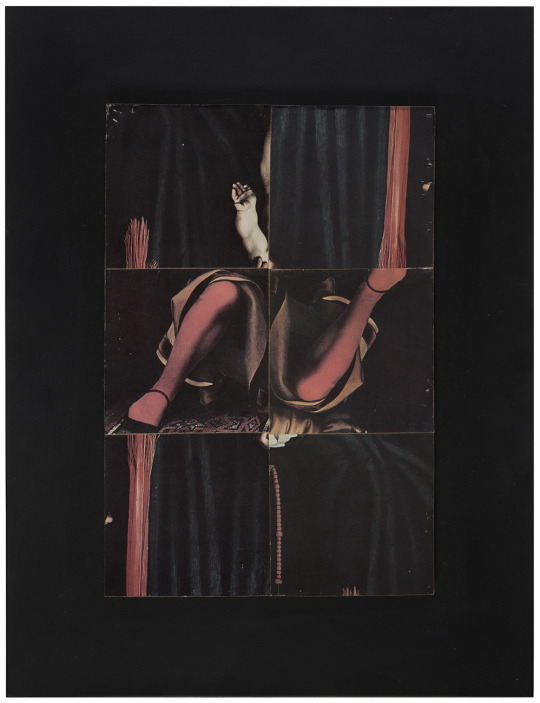
Gherasim Luca (1913–1994) | Cubomania entitled “Madone du Bourgmestre Meyer (d’après Holbein)”, 1983 Collage of photos on board, mounted on a wood panel, 34.5 x 26 cm ©Beaux-Arts, Paris
Originally from Romania, from the early 1930s Gherasim Luca (1913–1994) formed close links within the French art world, notably among the Surrealists; he settled permanently in France in 1953. Described by Gilles Deleuze as the “greatest poet in the French language,” Luca cultivated “hero-limit” work, to use the title of one of his pieces (“héros-limite,” 1953), where the deconstruction of language is based on the rejection of political, identity, and ethical categories, and reliance—twenty-five years before Deleuze and Félix Guattari—on anti-Oedipal notions. His atypical path, with the creative process is inseparable from his personal life, naturally led him to transcribe his poetic experiments into the visual arts. In addition, particularly from 1945, Luca embarked on a series of collages made from various photos of illustrations, and more significantly, reproductions of paintings, cut into squares of equal dimensions. He glued these squares side by side to form new, original, and surprising images, following a process very much inspired by the Surrealists. He called these works “cubomania,” to invoke the square’s foundational role, but possibly also as a way to mock the heirs of Cubism.
Beyond the Surrealists’ influence and that of the scandalous L.H.O.O.Q by Marcel Duchamp (1919, Musée National d’Art Moderne, Paris), Luca’s “cubomanias” of Luca staged a personal dialogue with celebrated works of art history, from Leonardo da Vinci to the Van Eyck brothers, Caravaggio to Ingres. In this work, Gherasim Luca’s point of departure is one of the best-known paintings by Hans Holbein, the Darmstadt Madonna (1527), also known as Madonna of the Lord Mayor Jacob Meyer zum Hasen, now held privately and shown in Schwäbisch Hall, but which at the time was on display in the Schlossmuseum Darmstadt. In this work Luca made particularly masterful use of the reproduction and the cropping techniques that make his cubomanias so original, using the leg of the patron’s son twice with different cut-outs, as well as the Virgin’s red belt three times. Recomposed in this way, right-side up or upside down, these figurative details take on a profoundly abstract character, reinforced by the opposition between black and red, in addition to the new continuities that Luca proposes through the association of elements that are identical in size and color. Additionally, the forms extend into the black of the support, suggesting the unfinished nature of the work, to be continued in the viewer’s imagination. Investigations into Luca’s “cubomanias” has particular resonance with the work of Holbein, who is famous for harnessing the dreamlike power of deformation by placing an anamorphosis in the center of is most famous work, The Ambassadors (1533, National Gallery, London).
52 notes
·
View notes
Text
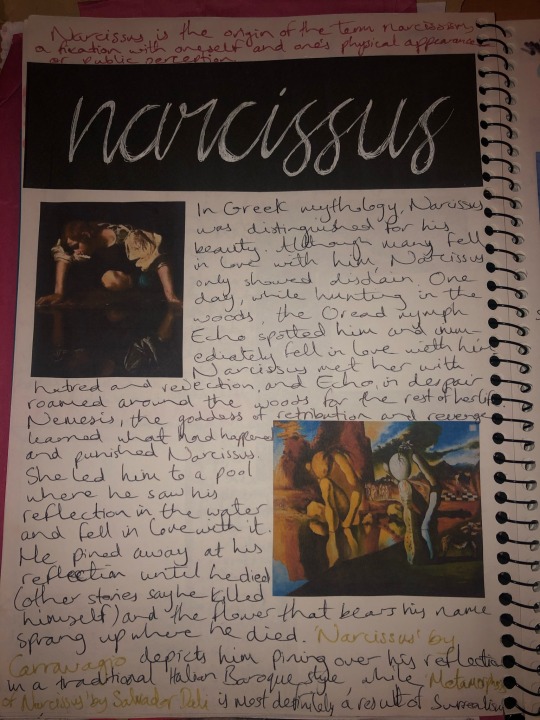
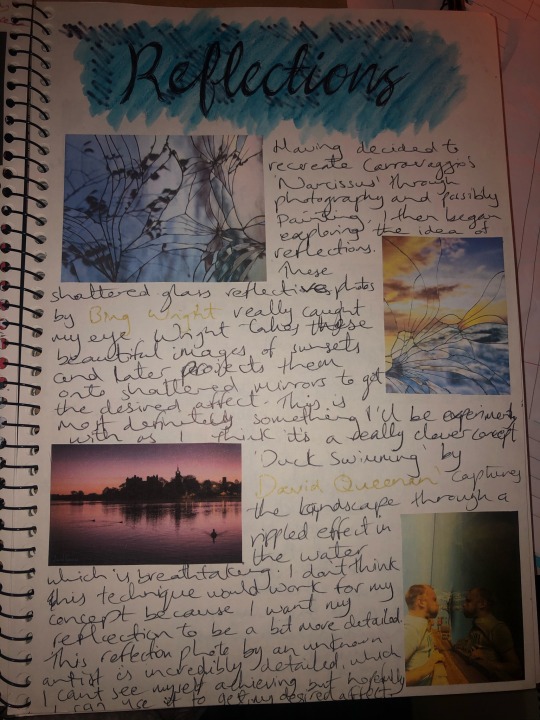
Research -Narcissus & Reflection Photography
To develop my exploration of Narcissism, I began researching the origin of the word, which is the Greek mythological story of Narcissus. According to this story, Greek God Narcissus sees his reflection in the water and falls in love with himself. He pines away for days and days at the river bank, until eventually he dies, only to be replaced by a flower which now bears his name. This story has been brought to life by both Caravaggio and Dali.
The story of Narcissus inspired me to think about reflections, particularly through photography as I feel that’s the most effective way to capture them. Upon researching reflections in water, glass, mirrors etc. I found Bing Wright. Wright creates these incredible broken compositions by projecting his photographs of sunsets onto broken mirrors. I found this process to be quite impressive as I feel it’s a very clever way of creating a broken glass effect. I intend on trying out his technique myself, as I think it’d portray the not-so-pretty side of Narcissism quite well.
2 notes
·
View notes
Text
Leonardo - A Radical Suggestion
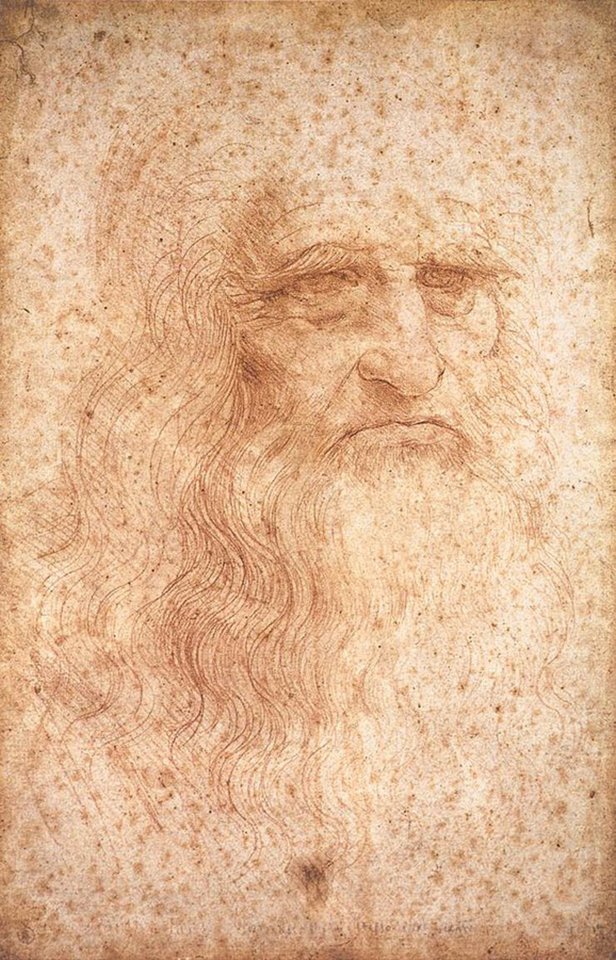
1 : INTRODUCTION
For those of us who operate in the Arts and not the Sciences, what is the difference, I wonder, between a hypothesis and a thesis? If both are based on research, is it mostly a degree of conviction? What begins as one can turn into the other. For my part, as I will set out in this essay, what began as an inkling regarding certain pictures ‘by Leonardo’ is now a genuine conviction which has become nailed to a Lutheran door, as it were, as an article of faith. There is something risky about it, it is provocative, radical in fact and will doubtless be considered heretical by those with a settled opposing view. My proposal is this: I believe that four paintings which currently bear the ‘Leonardo’ attribution are not by Leonardo, but the works of two other artists: three by Ambrogio de Predis and a fourth by an unknown hand. I will demonstrate how, using methods of connoisseurship, it is possible to discern the techniques of these other artists in the paintings whilst also offering comparisons to genuine works by Leonardo. I will be looking at the following paintings (left to right): The Virgin of the Rocks (National Gallery London), Ginevra de Benci (National Gallery Washington), Portrait of a Musician (Ambrosiana, Milan) and Lady with the Ermine (presently at Wawel Museum Krakow)

Opinions such as these are likely to provoke outrage quickly turning to contemptuous dismissal, especially among the curators of the galleries concerned. The National Gallery in London, for example, despite already owning the genuine Leonardo Cartoon of the Virgin and Child with St Anne – a drawing, albeit a large one – has placed a great deal of significance in its claim to owning an important painting by the same. Similarly, the National Gallery in Washington has accepted its Ginevra de’ Benci as authentic Leonardo for so long, it has appeared in so many books on him and been seen as his by so many gallery visitors, that any suggestion to the contrary is likely to be dismissed as weird or ridiculous. The portrait of the Lady with the Ermine at Krakow is so confidently ascribed to Leonardo that she even became the poster-girl for the 2011 Leonardo exhibition in London.
In view of this expected hostility I feel it prudent to revert to the more tentative position of having a hypothesis or hunch, a voice that says ‘Suppose that this is the case, what are the arguments for it, what is the visual evidence?’ Hence the title of this Study: a supposition or ‘radical suggestion’.
Before looking in detail at pictures and drawings it is helpful to reconsider what kind of a man Leonardo was. What impression do we gain from all his drawings and notebooks, the records of his thinking? Surely it is of a person of immense curiosity. Mentally he was always moving on, investigating the forms and mechanisms of life, inventing solutions to problems, addicted to exploring the variety, complexity and sheer beauty of anything he encountered. There was, however, a synthetic aspect to his imagination as well as the analytic one, and every now and again he turned to painting and through it gave expression to that poetic rather than scientific side of his nature. This switch occurred at intervals in a life otherwise devoted to description, analysis and problem-solving. Hardly a day passed, one imagines, without him drawing and making notes, but months, even years may have passed in which he was not painting, though a painting awaited his return to it. Even without the subtractions I would make, what has survived of his painted oeuvre is small relative to that of any other major artist one can think of. Painting was not a constant preoccupation of his life, though he took its practice seriously and was interested in its status vis-a-vis other arts.
I : LONDON AND PARIS

The Virgin among the Rocks - National Gallery London
Given all this, what are we to make of the proposition that Leonardo made a large-scale copy of one of his own works? How likely is it that such a restless mind would allow itself to be detained for as long as it would take to paint a huge version of a composition which he had earlier completed and from which he had mentally moved on? Even if some circumstance had forced this on him, would he not have taken the opportunity to make revisions of the composition far more radical than we see? Beethoven at the piano was inspired and inventive: when he took his hands off the keyboard and a lady exclaimed that she would never hear such a thing again, he replied, so the story goes, ‘oh yes you can, madam’ and started off again, yet not repeating himself but inventing along the way because he could not help doing so. The same is surely true of Leonardo, witness the profusion of compositional ideas scattered through his drawings.
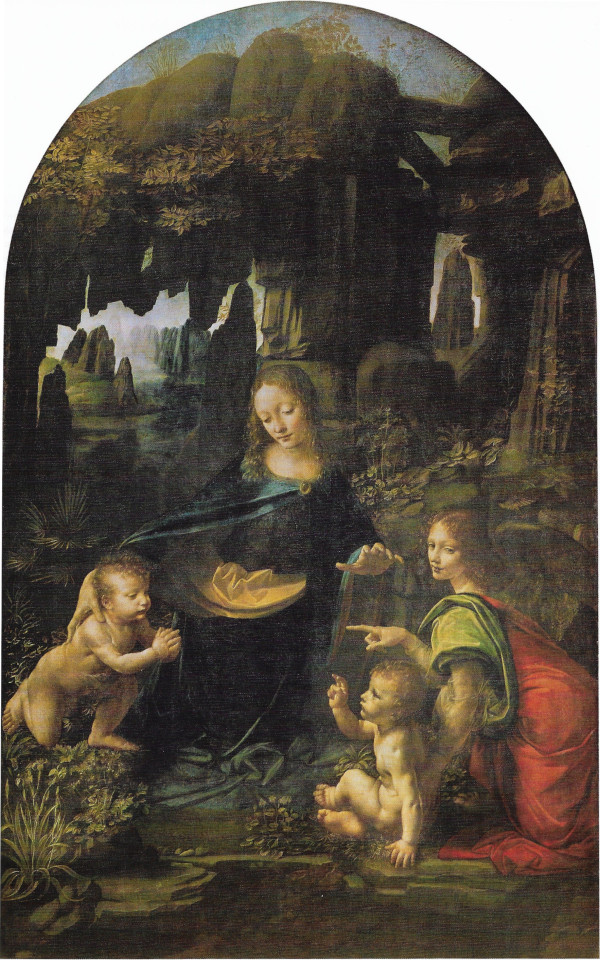
The Virgin among the Rocks - Musée du Louvre Paris
The Louvre Virgin among the Rocks is authentic Leonardo, I have no doubt. The forms of the figures, the shape of their faces, the drawing-related observation of plants and rocks, the suggestiveness of the cavernous environment, and the warmth of the palette, are all entirely characteristic of him.
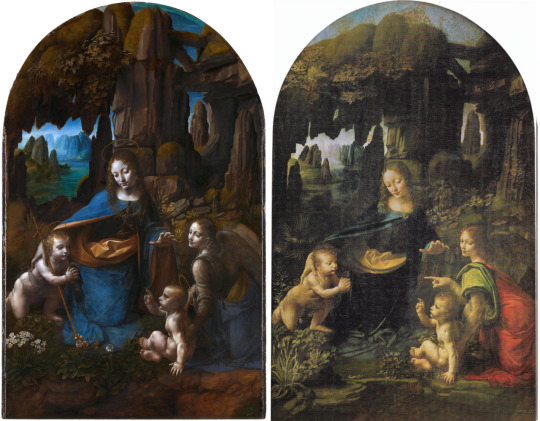
The Virgin among the Rocks - London (left) and Paris (right)
It is the status of the London version that one has to question. The composition is broadly the same, but the colour scheme is colder and bluer, the handling of paint heavier and more prosaic, the atmosphere sepulchrally chilly.

Detail of the Virgin’s head in both paintings
One of the differences between the Paris and London pictures is the lighting which affects, of course, the colouring. In Paris we have a light reminiscent of evening, the western sun to our left; faces, hands and naked bodies glow with a golden warmth. The arm of the infant Saint John, pressing for balance on a ledge of rock, is like an arm in Caravaggio, lit dramatically with warm shadow. Despite the cold, damp, uncomfortable setting, there is the residual warmth of a day, embers of a fire that the angel’s red cloak under the greenish-grey mantle keeps alive. In London we have a lighting closer to moonlight, colder, whiter and bluer; the faces and bodies are illuminated more emphatically but less subtly. This relative heaviness and simplification does not suggest Leonardo but is characteristic of Ambrogio.

Colder blues in London, warmer lights cast in Paris
The circuitry - like a cat’s cradle - of hand gestures and eye focus that depends, in the Paris picture, on the Virgin’s left hand being poised above the angel’s pointing one, is broken in London by the latter’s omission; it is earthed instead by the long diagonal of the Christ-child’s cross. Something important is being left out and the resulting void is a central darkness that engulfs the raised hand of Saint John. Similarly, the beautiful iris and fern at lower left in Paris are replaced by less complicated flora not based, as Leonardo’s are, on drawn observation.
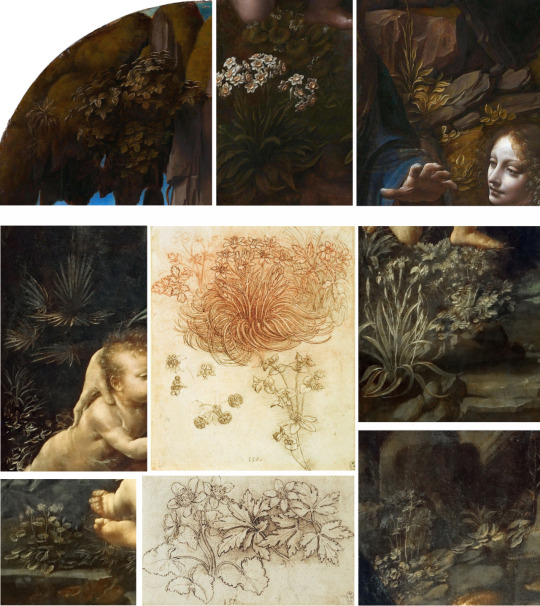
Top row - simplified plants featured in London painting; Centre - Leonardo’s studies of plants; Either side - more accurately observed plants featured in Paris painting
In London the rocks seem heavier and more depressive on the figures because they continue to the top and omit the arching of rock against sky which in Paris reinforces the Virgin’s ‘misericordia’ gesture as she puts her right arm round the head of her Son. The highlight in the gold mantle under her blue robe has a more complicated and spirited calligraphy in Paris and is omitted altogether where it appears in the Paris angel’s shoulder-wrap.
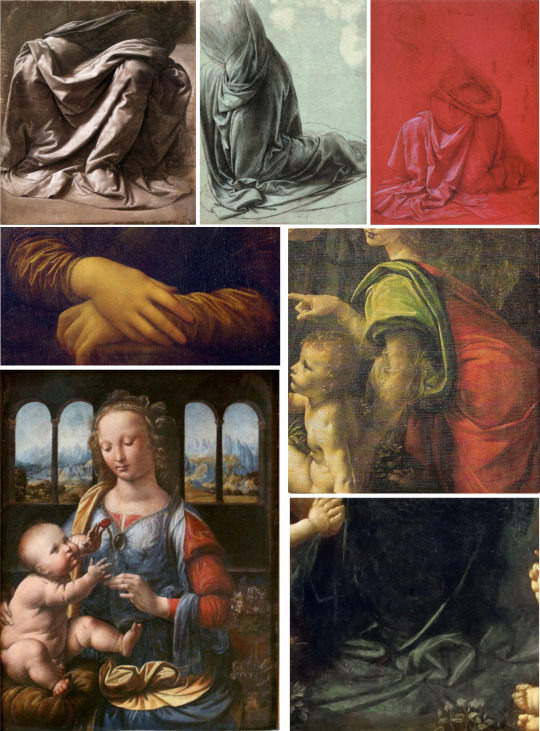
Leonardo’s eye for capturing the highlights and shadows of draped fabrics, clockwise from top left: Three drapery studies; Angel’s robe in Paris ‘Rocks’; Virgin’s hem in Paris ‘Rocks’; Madonna of the Carnation (Alte Pinakothek); detail from Mona Lisa (Musée du Louvre)
A theme in these Studies, and one of the insights that connoisseurship constantly throws up, is that how an artist draws will often if not always be reflected in how that artist paints; pencil and brush are used in similar ways. If, as I suggested earlier, Leonardo drew every day, it is very likely that when he painted, especially when he used a fine brush for more detailed final delineations, of plant stems or the highlights on sleeve-folds for example, we will see a resemblance between his mark-making with a brush and his mark-making with pen or pencil, chalk or silverpoint. And so it is, as these examples show.

Material details - fabric folds in Paris (left) and London (right) paintings
In the London version these final touches are absent because Ambrogio did not have Leonardo’s curiosity about natural forms, and his representations of them are inevitably more generalised and emblematic. Were I a supporter of the Leonardo attribution for the London picture, this omission would worry me greatly. Turn to drawings by Ambrogio, on the other hand, and one sees at once the coarser grain that is evident in the London Rocks.
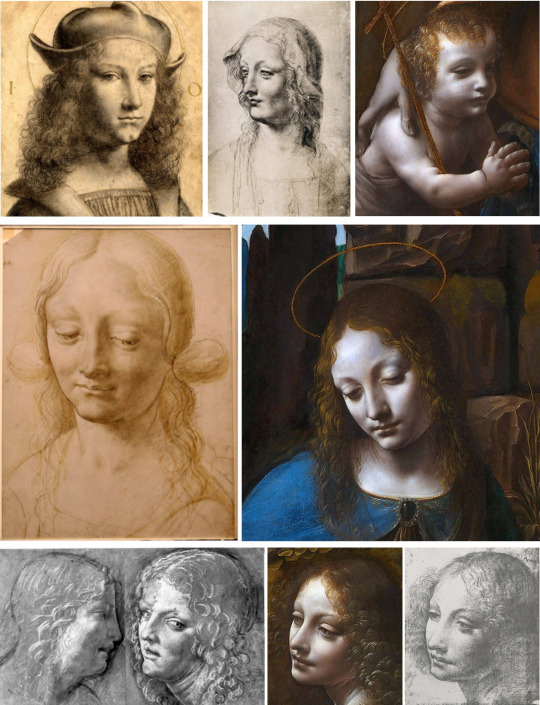
Facial types in works by Ambrogio show wide eyes like those in London 'Rocks’
One begins to think that some of the challenges of making a replica of the Paris picture were just too demanding for the copyist, hence his omissions and the substitution of linear props like the cruciform staff, the haloes, and the vertical hemline of Mary’s robe. The major difference, however, remains the chromatic one: doing away with the angel’s red robe, combined with the loss of a quintessentially Leonardesque relationship between that red and the green, blue and yellow-gold in Paris, seems the surest sign of all that we are not looking at Leonardo’s work in London but at that of an artist who is happiest working with a palette of cold blues and browns.
2 : WASHINGTON

Cold blues and browns: that is what we find, among other signs, in the Ginevra de’ Benci at Washington (above) - the brown in the bodice, the blue-brown landscape beyond a sallow moon-face. particularly noticeable in that face are the high temple above eyes far apart, and cheekbones even farther apart with shadow under them level with nostrils, making mouth and chin seem disproportionately small. This is not a Leonardo construction of a face, but if one turns back to the London Virgin among the Rocks, it is there in the angel’s face and the Christchild’s though to a less exaggerated degree.
Noticeable, too, are the heavy upper and lower lids to rather long eyes. Here are some drawings, plausibly by Ambrogio de Predis, which reinforce these features as typical of his style.

Recurrent in them is a certain heaviness, an overemphatic modelling and lighting, the strange eyes, the long, broad nose, and a scale that seems to enlarge as one ascends from the chin.
There is a further feature to remark on in the Ginevra and that is the treatment of hair strands and hair curls: they look metallic, as if made from fine picture wire, and the curls are tightly coiled as we see in several drawings. This is Leonardesque in general - it reminds one of his deluge drawings and water studies - but Leonardo the painter does not apply the curling tongs in such a steely manner, there is more poetic sfumato blending the ringlets into shadow, exposing here, losing there. They should not assume more importance than the facial features.

Ginevra de Benci’s tight curls as compared with those from works by Ambrogio - there is a further connection between the painting (bottom left) of St John the Baptist and the inscription on the reverse of Ginevra’s portrait
If I seem to denigrate Ambrogio de Predis vis-a-vis Leonardo it is because the distinction to be made is not just of style but of quality. His way of painting, as of drawing, is heavier, colder, cruder and far less poetically evocative. To make a version of a Leonardo on the scale of the London Virgin among the Rocks is undoubtedly impressive and Ambrogio is a very accomplished artist, but when attribution is at stake it should be recognised, after due consideration and comparison, that his painting in London is nothing like as good as the Paris original. On every measure the Louvre picture is superior. As for the Ginevra, just put it beside La Belle Ferroniere or Mona Lisa, (below) and see how it fails on both connoisseurship counts, likeness and quality.

3 :MILAN
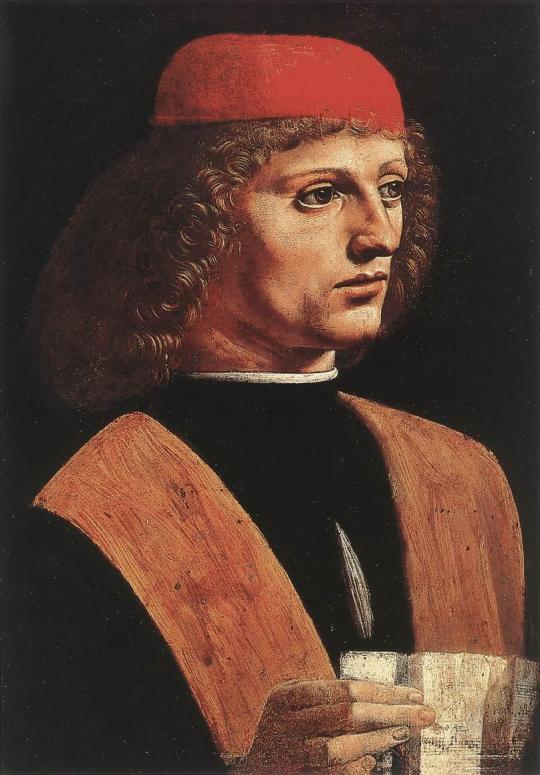
There is another ‘Leonardo’ that fits well with these attributions, and that is the unfinished Portrait of a Musician at the Ambrosiana in Milan (above), a painting which Giovanni Morelli long ago assigned to Ambrogio, I think correctly. We are presented here with a memorable face and a convincing portrait of an individual, but once again the exaggerated lighting, the shape of the eyes and lids, the mouth, the wire-like curls and the low-slung cheekbone that is level with the nostril and far from the eye, betray, when taken together, the style of Ambrogio, not Leonardo.
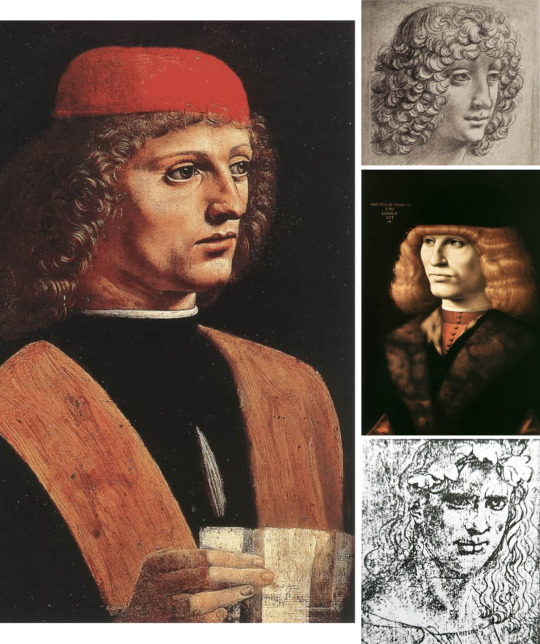
The Portrait of a Musician and three works by Ambrogio all displaying similarly wide eyes and facial types - Head of Francesco Melzi; Portrait of a Young Man; Head of Bacchus
It is a style that produces an impression of forceful character, but just because it errs on the side of being over-determined it lacks the subtler sfumato, the more reticent but mysterious presence that is the ‘poesia’ of Leonardo. This is more assertively a portrait, but Leonardo, who was no more interested than Michelangelo was in the individual - and therefore not at heart a portraitist at all -aspires to a more universal and depersonalised image, the sublimated type of Mona Lisa. The contrast between the two men is admittedly disguised somewhat by the assimilation to Leonardo’s manner - Ambrogio was, after all, his close associate and admirer and his work is more nearly Leonardesque than most of the master’s followers - but the differences are there to be discerned and if we do not discern them I fear that our conception of Leonardo the painter will remain blurred by inconsistencies that distort our proper understanding of his development. He did develop, but credibly, not by suddenly adopting a new palette or a new way of constructing a face.
4 : KRAKOW
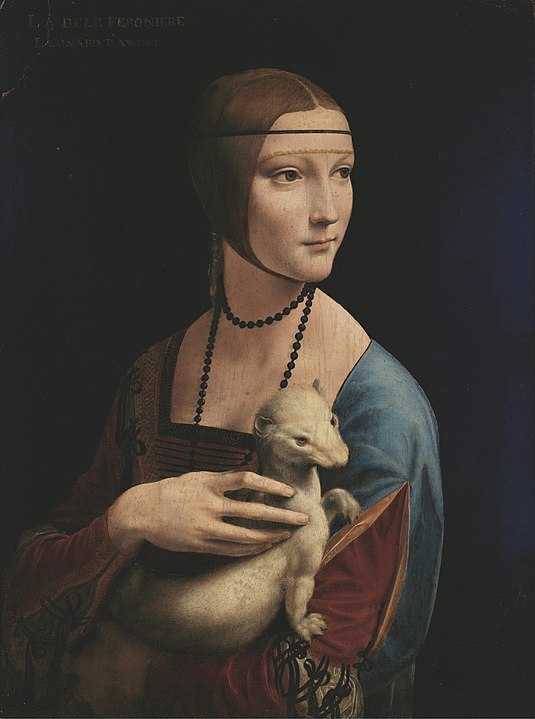
The focus of this Study being on what is, and is not, by Leonardo, I can leave Ambrogio now and turn to a work not by him but not, I believe, by Leonardo either, accepted though it usually is as an important example of his art: the Lady with the Ermine portrait of Cecilia Gallerani at Krakow. Whatever one’s theory about its authorship, few would disagree that it is a work of high quality, beauty and sophistication, almost certainly from the best years of its maker.
With that tribute to the work I shall cut to the quick of the connoisseurship argument by setting it between three other items (clockwise from top right): a painted Portrait of a Lady from the Musée Jacquemard André in Paris, a very impressive portrait drawing of a Woman, from the Uffizi Gabinetto and a profile Portrait of a Woman from the Kress Collection at Washington.
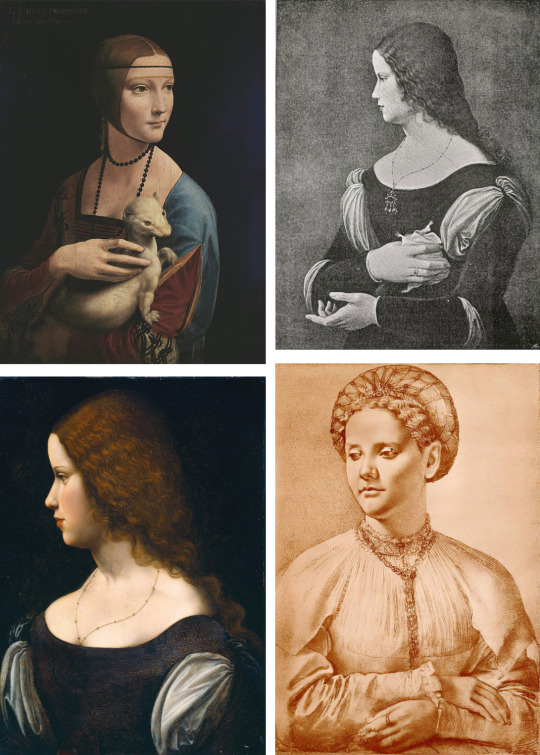
The salient features linking them are the smooth Bronzino-ish modelling, the profiles, the flesh colour, the treatment of folds in sleeves, and the form of the long-fingered hands. That curious pose of Cecilia’s right hand with its long and separated digits is not to be found, I think, in genuine Leonardo, but we shall see that it recurs in this master’s work.
With these initial comparisons in mind one can go on to other drawings and paintings bearing similar characteristics. The very soft muzzy shading within fine linear contours and hairline comes again in a drawing from the Pembroke collection at Wilton House; the woman’s profile repeats that of the Lady in the Kress painting.

Profile of a Woman - Wilton House
At Windsor, in the Leonardo corpus, are three studies of feet, one a child’s, that are clearly in the style of the drawing of the Lady in the Uffizi and the Pembroke drawing. A further drawing, from the Ambrosiana in Milan, not only belongs with it in drawing style but also makes a link with the Krakow painting of Cecilia Gallerani.

One sees the fastidiously neat, centrally-parted coiffure, relatively slight eyebrows, long nose, similar mouth, pointed chin. Some of these items might even be of the same woman; however, it is similarity of type and style, not identity of sitter, that is relevant for attribution, and as a group these drawings and paintings already suggest a common style and a common authorship that is distinct from what we recognise as ‘Leonardo’, and distinct also from Ambrogio de Predis. An artistic personality begins to emerge that makes the attribution of the Krakow picture to Leonardo seem increasingly unsafe and improbable.
The improbability is only confirmed when one moves to a painting of the Virgin and Child with an Angel and Saint John at a museum in Budapest. Here is the Krakow hand; here the marmoreal smoothness and delicate blush to the cheek; here a deep wine-red under blue mantle (and over a black-striped white silk undergarment); here the brown colour (in Cecilia’s right forearm; the wooden border of the angel’s lute); here the precise coiffure, pointy chins, delicately defined finger and toe nails.

Painting of the Virgin and Child with St John shows near identical hand posture to Lady with the Ermine, as well as similarities to unattributed studies of a child’s head (Musée des Beaux Arts Caen) and an engraving of an Old Man (Metropolitan Museum New York)
Relevant to this work in Budapest is a drawing in the British Museum (below) where the Child’s hand raised in benediction is much the same, and the Virgin’s hands around Him similarly arthritic but almost claw-like.
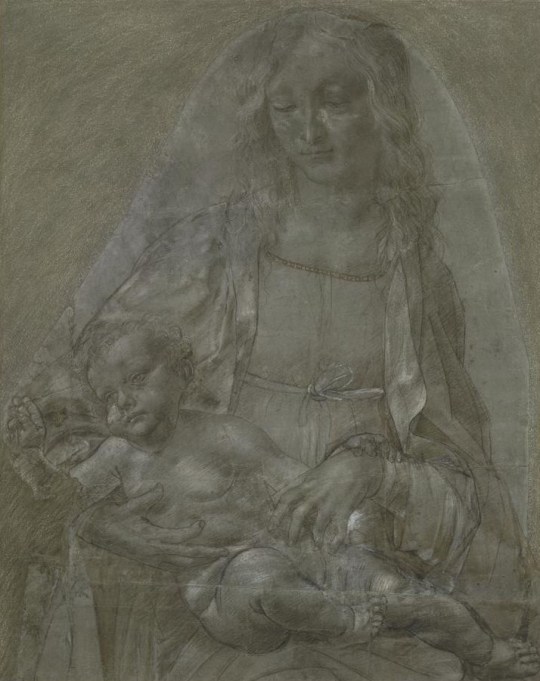
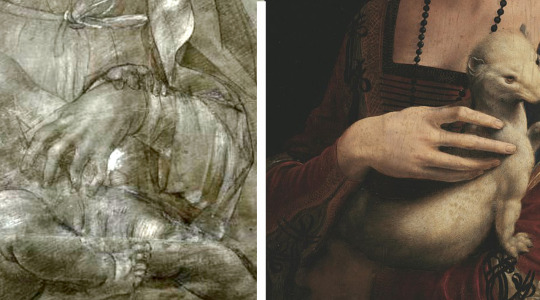
Enhanced close-up of the hand from the drawing showing a similarly “double-jointed” hand to that of the Lady with the Ermine
A much annotated drawing in the Uffizi, purporting to be of Beatrice d’Este, shows the Krakow Master’s refined line, but adding eyelashes which Cecilia Gallerani lacks. There are similarities between this Uffizi drawing and a supposed self-portrait drawing of Melzi at Bayonne: the same smooth modelling and combed hairlines (below).

Mention should be made at this point of an earlier, very charming work, a reliquary from the Sanctuary at Crea which has a portrait on one side of the Marchese di Monferrato and on the other his wife, Anna d’Alencon.

The portrait of the Marchesa is particularly close to the Krakow portrait, not in date but in profile, shape of face and facial features, treatment of hair, black necklace, juxtaposition of brown and slate blue.
More paintings and drawings, some in pen and ink, could be introduced to flesh out the career of this artist and take it back to its beginnings or forwards, to the Sforza Altarpiece; but for present purposes enough, I hope, has been garnered to make the case that the picture, fine though it is, is not by Leonardo but by another artist working at or near the height of his powers.
5 : CANON
Between the subtractions from the current Leonardo canon that I have proposed above and some additions to it that I would like to put forward for consideration, we can usefully mention what remains that is generally undisputed. With regard to early work there is room for dispute. I would argue, pace Vasari, against his having painted an angel in Verrocchio’s Baptism, on the ground that I see no difference between the two angels in the way they are painted, and that that way was Verrocchio’s way, as a drawing by him makes clear.
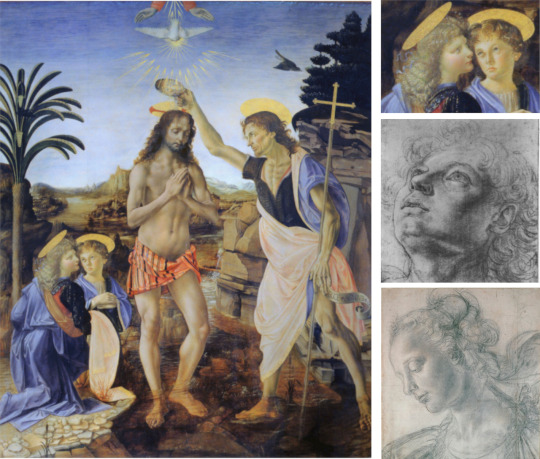
Verrocchio’s Baptism of the Christ and drawings of the Head of an Angel (Uffizi) and the Head of a Woman (Christchurch)
On another occasion I would at least cast doubt on Leonardo’s hand in the painting of the Virgin’s and angel’s heads in the Uffizi Annunciation while not denying that he contributed to other parts of both that picture and the Verrocchio Baptism. There is also an argument to be made about the authenticity of the much repainted Benois Madonna in the Hermitage.
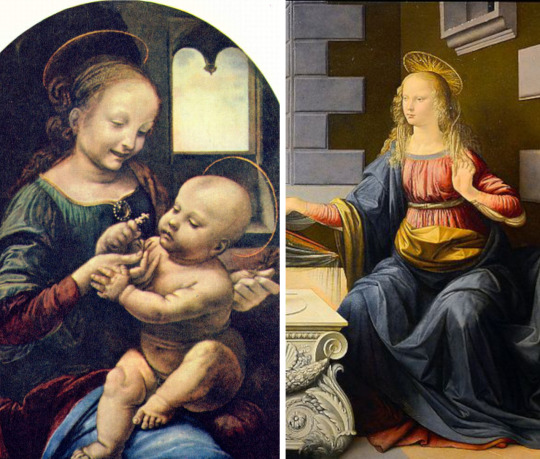
The Benois Madonna (left, attributed to Leonardo) bears similarities in style with the Virgin from Verrocchio’s Annunciation (right)
Apart from numerous drawings, the London Cartoon among them, we are left with the five pictures in the Louvre (Madonna of the Rocks,Virgin and Child with Saint Anne, Mona Lisa, La Belle Ferroniere, and Saint John the Baptist); the Madonna with the Carnation at Munich; the Last Supper fresco at Milan, the unfinished Adoration of the Kings in the Uffizi; and the unfinished Saint Jerome in the Vatican. What, if anything, can be added?

Leonardos at the Louvre
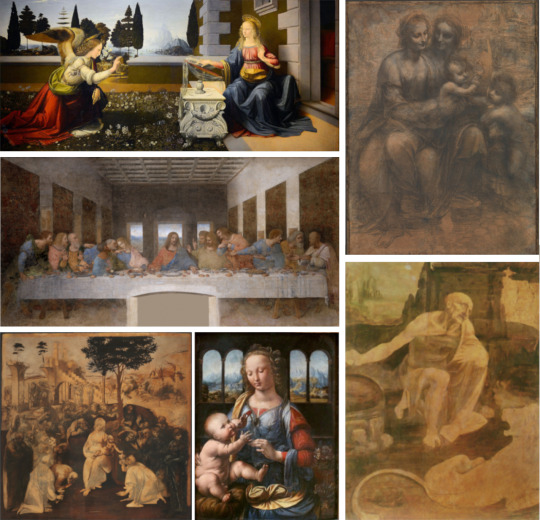
Leonardos around the world
5 : ADDENDA
I have not seen, nor do I know the location of, this probably small painting - perhaps a fragment, perhaps of the head of the Virgin (below). It was once in a private collection in Lugano, but is known to me only from a small but fortunately colour reproduction in an obscure catalogue of an exhibition of ‘Masterpieces of European art’ compiled by Amadore and Tony Porcella, at Tally Ho, Las Vegas, in 1963.

The book is a curious miscellany with some questionable attributions, but this one image has stuck in my mind and I remain as strangely confident now as I was when I first saw it that the original, if one knew where it was, would turn out to be a genuine early work by Leonardo, as the Porcellas claimed.
Place this image next to the renowned drawing at Turin of a woman’s head, and it is fairly easy to turn that head around a little and down a little to get the same or a very similar physiognomic type that is classic Leonardo. Place it against the Angel’s head in the Louvre Virgin among the Rocks and much the same match is achieved, with also, significantly, the same combination of red and green from a palette that is decidedly warm - the necessary warmth of an umber ground for anything to be by Leonardo.
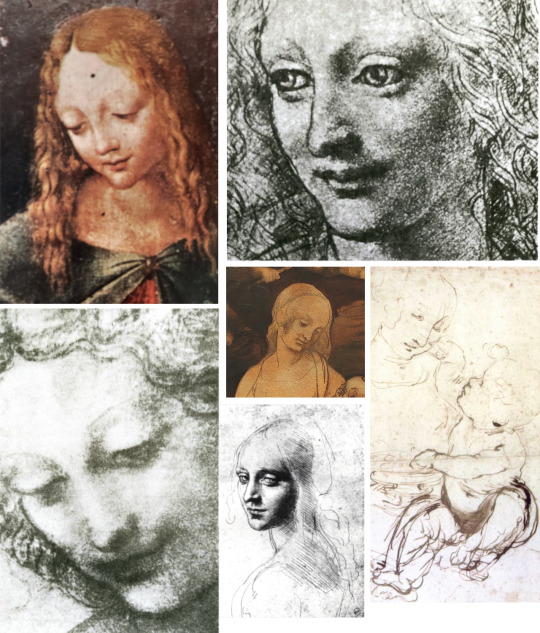
Faces in drawings by Leonardo compared with Porcella image
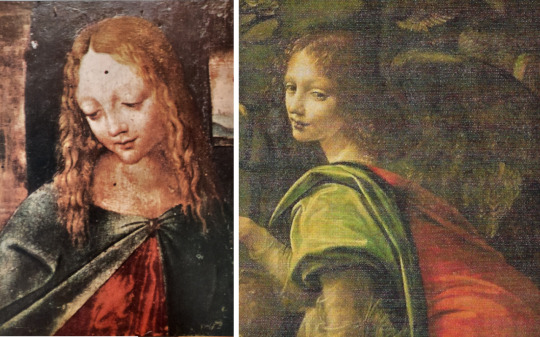
Colours in both Porcella image and Louvre Virgin of the Rocks
My other proposal on the credit side is a painting at Wilton House near Salisbury, one of a number of extant pictures on the theme of Leda and the Swan, a subject known from his drawings to have occupied Leonardo’s attention. This Wilton Leda is ascribed to Cesare da Sesto.

Leda and the Swan attrib. Cesare da Sesto - Wilton House
When I saw this Leda in the National Gallery’s 2011 Leonardo exhibition I remarked to my companion ‘Isn’t this good enough to be Leonardo’s?’ and added, to myself, ‘but I suppose the experts know something we don’t’. Now, after further consideration - seeing how faithful all aspects of the picture are to the pictorial language and practice of Leonardo, and finding in the language and practice of Cesare da Sesto nothing that convinces me that he could mimic Leonardo’s so perfectly - I simply ask of those experts: if I am missing something on the visible surface of that picture that clearly demonstrates that it must be by Cesare da Sesto and cannot be by Leonardo, please provide an equally visual argument to explain that case. To my eye the head of Leda is nowhere near the characteristic female head in Cesare’s work, but is extremely close to well-known drawings by Leonardo.

Examples of Faces in works by Cesare da Sesto - details from Madonna and Child with the Lamb; Study of a Man’s Head; detail from Madonna and Child with Sts John and George

Studies for Leda and the Swan by Leonardo at Chatsworth (Top Left) and the Royal Collection at Windsor
The warm palette and all the background and foreground of the composition are likewise relatable to Leonardo and to studies by him of mountains, children and plants.
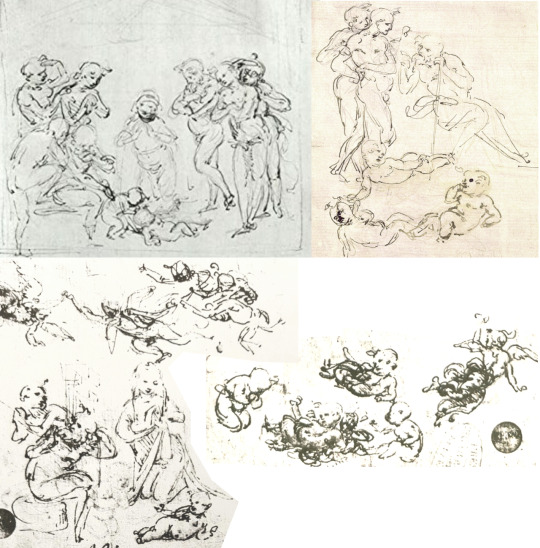

The children in the painting are reminiscent of sketches by Leonardo
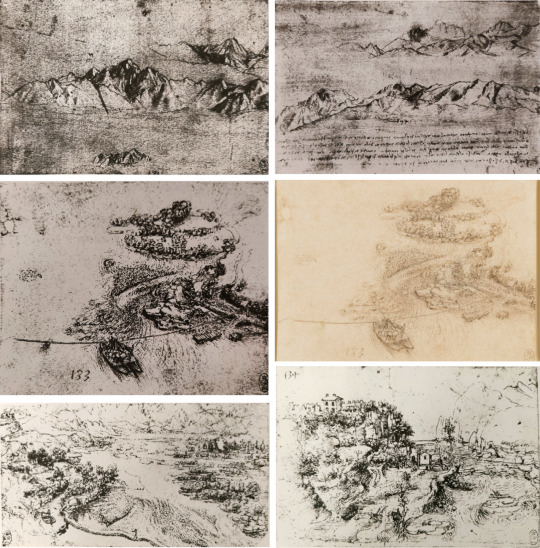
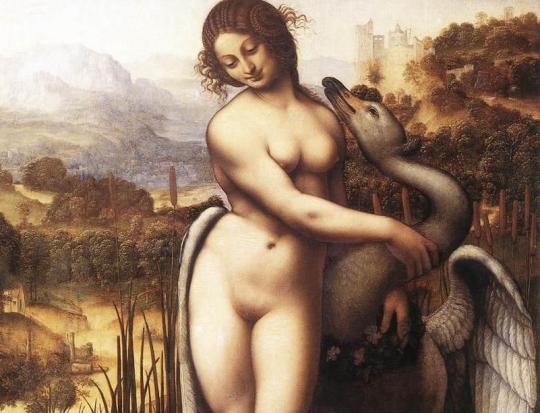
Landscape details can also be compared to studies by Leonardo, like those at the Royal Collection
Of course artists make copies of work by other artists, but in doing so they cannot help unconsciously introducing traces of their own habitual styles of figuration, physiognomy and palette. We know that even an artist with a conscious desire to deceive people (who therefore studies what he copies very carefully) betrays these personal idiosyncrasies. The Wilton picture, I suggest, merits consideration as authentic Leonardo. It is a work of remarkable quality, better, surely, than anything Cesare da Sesto ever achieved, and I would be quite happy to see it slipped into the oeuvre of Leonardo pittore, somewhere, at a guess, before Mona Lisa, because of the less veiled and mysterious landscape. I would add that what could be an autograph study for, rather than after, the head of the Wilton Leda is a beautiful grisaille (11 by 8in) sold by Christie in New York on 7 Dec 1977.
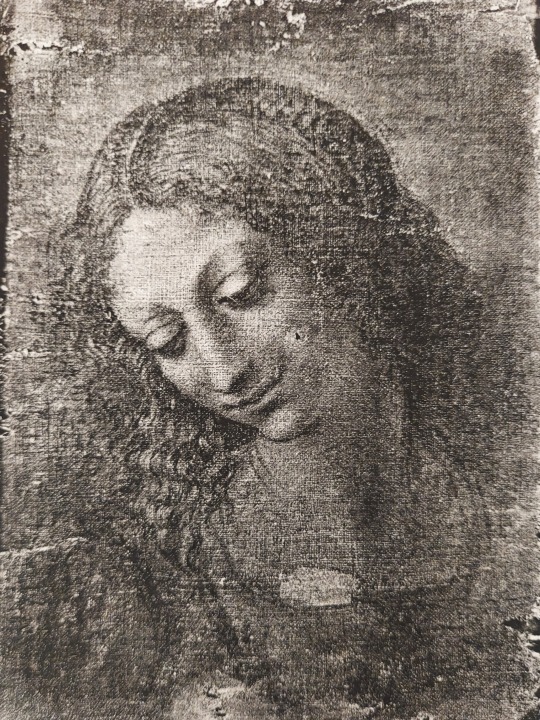
6 : CONCLUDING
I hope that this Study and its predecessors helps to demonstrate to anyone sceptical of the value of connoisseurship that, in common with any form of criticism, it is not a science but definitely a discipline, and one moreover that, properly practised, with plenty of close visual comparison can lead to a reappraisal, sometimes, as here, quite radical, of some of the leading lights in our pictorial heritage.The word ‘close’, however, is to be emphasised. There is no point in having a juxtaposition like this one (below) from a recent National Gallery exhibition catalogue, where the drawing is insufficiently similar to the detail in the painting and bears no resemblance to any drawing by Leonardo. Comparison must be accurate enough to advance an argument rather than spread confusion.

There is no lack of attention paid to Leonardo, but it is too often of a kind that produces claims of authenticity such as the Salvator Mundi of current fame, which connoisseurship, if applied, could show to be misplaced.
Alternatively, attention is of the kind that is not radical enough and tends to re-present the same items from one monograph or exhibition to the next, simply because it would look strange to omit them. The accumulated weight of past opinion confirms the rightful place of, say, the Ginevra de’ Benci in any presentation of Leonardo the artist. If it becomes unthinkable to leave her out, it becomes ever more eccentric to question her inclusion; so she is re-displayed or re-produced ‘on the nod’, with no questions asked.
There are, sad to say, vested interests at work here. The Ginevra, like so many famous images, belongs in, and to, a famous museum. Its curators, and curators everywhere, develop a quasi-proprietorial relationship with ‘their’ collections that is not so very different from that of private collectors. Naturally they do not want to risk asking, or inviting, questions that could undermine the prestigious status of a work in their care, lest doubts should lead to a less prestigious one. The reputation of connoisseurship itself has unfortunately been tainted by practitioners having these or other sorts of vested interest. Unattached to any institution I am powerless but lucky in this respect at least: being a private researcher I have no vested interest at all. Whether a picture is by Leonardo da Vinci or by Ambrogio de Predis is of no concern to me beyond my desire to ascribe it correctly, no matter who owns it or what its market value may be.
For all sorts of unquantifiable reasons I value Leonardo. I hope that the questions I raise here may lead to a more coherent, less inconsistent picture of his enduringly beautiful art.
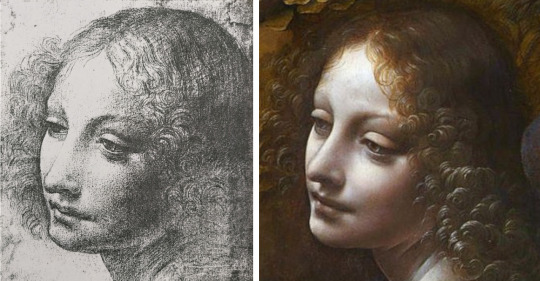
2 notes
·
View notes
Text
Domestic Science in Art
On Wednesday the 30th September, I attended a lecture in which my fellow art students and I were introduced by our programme leader to the concept of Domestic Science and how it relates to art, including the ways in which numerous artists had taken on their own homes or the very idea of the domestic and turned it into something creative and expressive.
One of those artists being Michael Landy who decided to rebuild his parents’ house in the Tate Modern in Liverpool. The model was of a smaller scale however it was an accurate replicate of the original. It was important and useful to see a certain difference in the way that the domestic can be depicted, this can be seen as a part of self understanding made prevalent in the works of the artist. Another example which we were introduced to was that of Caravaggio’s ‘Basket of fruit’, as he depicted a still life painting of a bowl of fruit which had appeared to be in the process of decaying. The painting itself appears normal at a first glance however at close observation we are made aware of its rotting state.
Here is the painting itself. Caravaggio - ‘Basket of fruit’
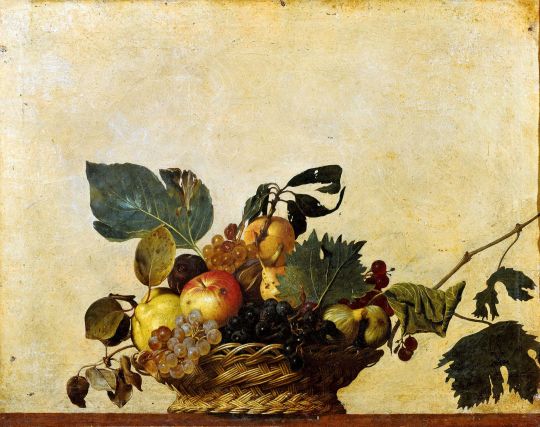
This is an interesting idea that particularly stands out as we can see something that can appear to be so simple can have such a deeper meaning that discusses darker topics of reality such as life, death, and the idea of the inevitable. It is important that we take into account the fact that a basket of fruit can be so commonly found in our homes yet we may easily ignore its beauty and significance, as well as the story that lies behind the development of the fruit. The relation between this painting of something so natural and the domestic is really intriguing and draws viewers in to the different possibilities of how the domestic can be presented through an artists perspective.
One artist we were introduced to on the other hand, had taken a different approach to the domestic altogether, straying away form traditional mediums he used the contents of the home itself to create art. Tonico Lemos Auad, a Brazilian artist, used the excess fluff from carpets to create small sculptures of creatures and animals, these were placed in different areas across his home. The scales of these sculptures ranged across all sizes, this work stuck out to me particularly because of the artists creativity and unique approach to applying the home to his work. Here is the image we were shown.
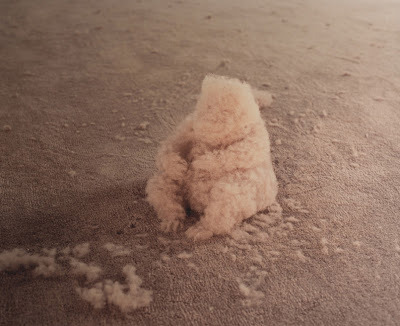
Personally, i was extremely impressed by this piece and the artists approach to reassigning something that is so commonly ignored and hardly ever considered a material for artistic use, and creating something so aesthetically pleasing and visually impressive. The reason i think i was drawn to this artist and his work the most was down to his general idea and the connection that his pieces have with his home. I feel as though the simplicity of the creatures is backed up heavily by the creativity of the materials used, there is a beauty within how simple the creature displayed above is positioned. There are feelings of tranquillity and rest, the atmosphere presented around the warm looking piece is something else that i find primarily stands out to me, as an outside viewer. It is also a great example of how traditional materials are not required to present something in an artistic form.
The work of Tonico Lemos Auad had a strong influence in the direction of my own worked produced, surrounding the idea of the domestic. I felt inspired by the ways in which emotion was conveyed and the very idea of sculpting itself. Following our lecture we were assigned a task in which we had to produce a piece of work that related to our homes, whether we made it fit into our own working spaces or made the space fit the piece itself. My personal response to this task, as previously mentioned, somewhat related to the work of Tonico’s, i wanted to sculpt something myself that conveyed some form of emotion yet stayed true to the idea of domestic science and the requirements of the programme leader. We had to base our pieces on words written by a selected partner about a previous meeting with a life model, the words we wrote explained both what we saw on screen and how we felt about the the way in which the model performed and presented herself. The words i was given by a fellow student consisted of a darker approach, which ranged from “humiliation”, “aggression” and “oppressive”. All of which i saw as a perfect opportunity to create something which emitted a heavy emotion.
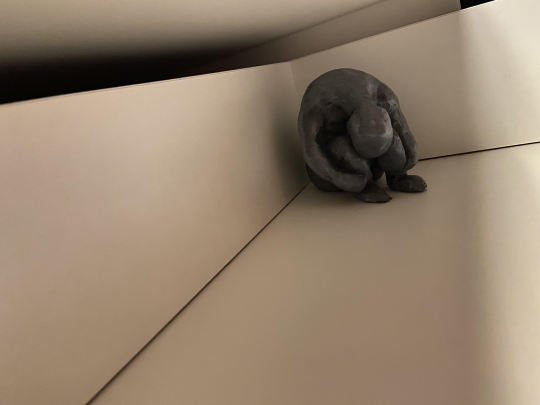
On the image shown above is my presentation of the words given to me through the form of a sculpture made using polymer clay. The sculpture shows a small figure with no identity in somewhat of a curled position, this was intended to provide a strong feeling of all the themes around sadness, embarrassment etc. The sculpture was painted dark greys in somewhat of a metallic shade, to emphasise the moody atmosphere being presented. The task we were officially given was listed as ‘matter’ this meant us creating something that fitted into a space and pushed us towards turning our own homes into workspaces. I decided that the most fitting space for my small sculpture was the inside of my desk drawer placed as though backed into a corner. I thought this was most appropriate given the ideas presented through the words i was provided hinted at the subject being a victim of oppression, and forced into hiding.
In contrast to the ‘matter’ task we were assigned a new objective under the title ‘antimatter’. This consisted of the deconstruction or reverse of our original creation in some way. This is what i came up with.

As you can see, the sculpture is no longer present, and in its absence is a pool of painted clay, which can be perceived as the remains of the previous body. My goal was to create the illusion of the small figure combusting/melting under the pressures of the outside problems listed above. This idea came to me through the actual process of finalising the sculpture, i was faced with the difficulty of keeping the actual piece together and preventing it from falling apart and colliding into a mess. These problems were the result of poor preparation however i feel as though it has luckily worked in my favour as i was allowed to both create the sculpture and reduce it in one sitting. Although the image above is not the natural result of the previous figure, it is still relevant in that it provides the illusion of an eventual decomposition. I thought this was also fitting to the idea of being inspired by the work of Tonico Lemos Auad as there was somewhat of a fragility about his sculptures, they appeared in their soft, fluffed texture to be easily destroyed, this was something i found comfort in, in the process of deconstructing my own work for the ‘antimatter’ task.
Following the presentation of domestic science we were introduced to a number of graduate students who wanted to share their individual experiences with the difficulty of adapting their final degree show and workspaces/studios due to the outbreak of the coronavirus. One of them being a student names Emma Dolan, who kindly enough produced a short autobiographical film to show how her experience had changed. We were introduced to her and her living/studio space and she told us of her coping methods in being trapped at home, she spoke about how she also felt that working alone had its benefits as opposed to the pressure of working amongst others as well as the downfalls. She had to learn new skills in website development in order for her degree show to succeed as well as adapt in many other ways such as being away from friends and moving back in with her parents. It was interesting to see the situation of unexpected changes in an important time period through the eyes of someone who had experienced it first hand, particularly through the creative form of a film. I was impressed by how she had adapted individually given the circumstances and intimidating short time period, leading her to success regardless.
The lecture itself introduced me to the idea of domestic science as well as an artist who i have taken interest in, it was also a pleasure to meet the graduate students and interesting to be given the ‘matter’ and ‘antimatter’ tasks and think in a way that id never have thought id find myself in, looking at my own home as something in which art can be developed and adapted to.
1 note
·
View note
Text
MAKING HISTORIES
Imagine you are going to curate an exhibition on the history of your discipline. Compile a list of 10 practitioners (or specific pieces of work) that you would include and write brief notes on why
I have chosen to focus on the history of painting...
Hieronymus Bosch (Netherlands)- Bosch’s major periods of activity were between 1480 and 1515. He was the first painter to depict images, beings and places unbeknownst to the human mind. Considered to be the first modern surrealist, Bosch captured what lies within the dark recesses of our consciousness, often painting scenes of carnage in hell and the paradise of heaven, playing on the fear and desire shared among humankind about what awaits them in the afterlife.
Caravaggio (Italy)- Caravaggio worked from around 1585 up until his death in 1610. His portrayal of religious figures was groundbreaking at the time, as he depicted his subjects as imperfect and hyper-real, by showing signs of aging and poverty. Although not invented by him, he was the first painter of his time to incorporate the chiaroscuro style into his work- very dark shadows and defined rays of light to emphasise certain areas of a painting. His work had a profound influence on later art movements such as Baroque.
Paul Cézanne (France) – In the late 19th century, post-impressionism emerged in France. Focusing on the subjective rather than the literal, Cézanne’s work is characterised by a vivid colour palette, painterly brushstrokes to create geometric forms, and creative compositions, which give a skewed perspective to what is seen with the human eye; the principle of distortion would later play a huge role in Cubism.
Kazimir Malevich (Russia)- Malevich worked in a variety of different styles between 1890 and 1935, but is most well known for inventing the Suprematism movement, his own philosophy in which he believes painting should transcend its subject matter, and focus more on shape and colour. He saw the canvas not as a window looking into a realistic scene, but as its own physical object in that exists in space.
Georges Braque (France) – Braque is best known for being one of the leading artists in the revolutionary Cubist movement; working from 1900-1963. He was introduced to Cubism after meeting Picasso, yet his own career spans beyond the movement. His paintings explore colour, line, texture and perspective within still life, and border on becoming patterns rather than the capturing of a scene. He experimented with blending sand into his pigments and stenciling words and letters onto the canvas. He was one of the first artists to include collaging news advertisements onto his paintings, which inspired modern art movements such as Pop Art.
Max Ernst (Germany) – After serving time as a soldier in WWI, Ernst emerged deeply traumatised and harbored hostility towards Western culture. Throughout his working life (1910-1976), he aimed to question and attack the conventions of what art is, focusing on depicting the subconscious and dreams, whilst still retaining some conventions of classical art. He aimed to freely paint from his inner psyche in order to work through his trauma, and was particularly interested in the art of the mentally ill as a window to the most primal form of creativity. He was a key player in both the Dada and Surrealist movements, and was also one of the first painters to apply Freud’s dream theory to tap into his own subconscious in order to produce work.
Robert Rauschenberg (America)- A pioneer in the Neo-Dada movement, Rauschenberg is best known for his experimental blending of media, and was one of the most well-respected artists of the 1950s. He merged fine art and found objects by use of collage, and often left the interpretation of his work to the viewer by leaving it up to chance where he placed each image. He focused on the role of the artist and the definition of ‘artwork’, often focusing on performance and conceptual ideas, thereby introducing a very modern take on image making.
Jackson Pollock (America)- Pollock’s troubled childhood and inner demons served as the fuel behind his wildly expressive and unique paintings. In 1939, whilst being treated for alcoholism, he was encouraged to paint and draw. His art serves not only as an outpouring of his own personal battles, but also as a depiction of the terror felt by humanity post nuclear war. His style is seen to be one of the most radical within modern art, detaching line from colour, exploring the body in art, and putting the artist ‘in the canvas’; the process of creating is the art itself and the series of actions behind it become the work, rather than just the finished product.
Gerhard Richter (Germany) - Richter played on the borders between realism and abstraction. He was fascinated by painting’s relationship with photography, and how each medium may claim to portray reality in its truest form, yet neither gives a complete and perfect view of a subject. He would project a photograph onto canvas and blur and distort the image within his paintings, suggesting that photographs have a life of their own separate to the subject(s) within them, almost like ghosts of the past. This gives the idea that our own vision is a conversion of reality to the imaginary. He worked alongside late 20th century movements such as Abstract Expressionism, Minimalism and Conceptualism, yet remained unique in his approach to painting.
Katharina Grosse (Germany)– Grosse is a contemporary artist whose work I am lucky enough to have experienced in person. Her vibrant, psychedelic colour palette sprayed in acrylic across gigantic canvases can be seen as an immersive gallery experience rather than just paintings. This submerges the viewer into a different reality, rather than them simply standing and looking in to something 2D. The pigments in her very modern colour palette would not have existed for a large portion of my timeline, and neither would the idea of paintings being a very immersive bodily experience- I have decided to end my history of painting with Grosse as I believe her approach to the discipline is as forward-thinking as the highly influential practitioners that came before her.
2 notes
·
View notes
Text
Which country inspired the majority of paintings by French artist Nicolas Poussin?

Although Nicolas Poussin is one of the most important artists in French history, he spent a large portion of his career in Italy. Born near Les Andelys in Normandy in 1594, Poussin grew up learning Latin but spent much of his schooling drawing in his sketchbooks. Although his parents disapproved of a painting career, Poussin ran away to Paris in 1612 to search for work as an artist.
At the age of 30, Poussin travelled to Rome, the artistic capital of Europe. He joined the Academy of Domenichino and the Academy of St Luke to study the art of painting nudes and took many opportunities to visit churches to examine the works of Raphael, Caravaggio, whose work Poussin hated, and other well-known Italian painters. Poussin fell in love with the architecture and statues around Rome, particularly the figures on ancient marble friezes.
As Poussin’s reputation grew, he gained patrons and admirers, including from his home country, France. One of his most prestigious clients, Cardinal de Richelieu, worked for Louis XIII, who was one of the most powerful people in Europe. In 1635, Richelieu commissioned Poussin to paint three Triumphs: 'The Triumph of Pan', 'The Triumph of Bacchus' and 'The Triumph of Silenus'.
In December 1640, he briefly returned to Paris to take up the position of First Painter to the King but found life in the royal court overwhelming. In 1642, he returned to Rome where he passed away in 1664.
0 notes
Note
What are Loki's thoughts on Midgardian art?
Initially, Loki is fairly dismissive of Midgardian culture in general. After all, what could mortals accomplish in their mayfly lifetimes that would even compare to the work of Asgardian craftsmen with eons to hone their craft?
But the more time he spends on Earth, and the more Midgardian art he actually sees -- the more he concedes that he may have been... somewhat mistaken.
The range of it astounds him. Asgard’s population is small, after all, with a single culture -- and that culture has been largely unchanging in its ways for thousands of years. The variety of art on Midgard, from nation to nation and period to period -- even the range by a single artist within their lifetime -- is astounding. Asgard’s art styles are not nearly so diverse. And while he’d be loathe to admit it aloud, he finds that some Midgardian art is frankly better, in how it is less stiff, more dynamic, and so real he nearly expects to figures to step right off the canvas.
Some of it is familiar. The northern peoples of bygone ages drew much inspiration from the Asgardian warriors who saved their forefathers from the frost giants. And some works remind him of the styles of other worlds. But some of it is new, and unlike anything he’s seen before, in every form from strange sculptural ‘installations’ in massive rooms to abstractly-patterned woven blankets of desert peoples.
The greco-roman style of sculpture, and the renaissance revival of it, with marble figures so animated he initially thinks them a victim of a cockatrice’s stare and not the product of a sculptor’s chisel, is particularly captivating to him. He loves how they contrast to the rigid, standing figures of Asgard’s halls, how the luminous marble diffuses the light in ways Asgard’s gold never could.
He’s also drawn in by the lyrical brushwork of certain Japanese paintings, with their delicate and deft manipulation of water and ink -- not ostentatious, but evocative and profoundly skilled. He does not know the stories they depict, but he’s left with an odd sense of wistfulness, staring at the images of mist-shrouded mountains and tumbling waterfalls.
And of the galleries in the Met that he wanders through, he finds himself perhaps most mesmerized by the Baroque artists -- by the supple rendering of flesh, the deep rich colors, the bright contrasts of light and dark and the breath-taking moodiness and drama of the works. He lingers in front of Rembrandt, and Caravaggio, and finds himself trying to see the humans of Midgard as these mortal artists saw them, saw themselves.
It is, he concedes in one of his few honest moments, enlightening.
116 notes
·
View notes
Text
In Praise of the Malteser
A long held ambition for us is now being achieved. We have landed in Malta. This section will be a bit of a sum up as the hectic days and sociable pace of the first month of the trip has meant the blog has been somewhat tardy on the production front. Or perhaps we are just getting old. Some brevity and celerity is required. Neither being my long suits. Anyway we'll try. We had had an early start, 6.15am for the bus to pick us up and one of those round all the hotels jobs (we were the first ones on) followed by a flight from Cappadocia and then 6 hours or so at Istanbul airport. This meant that by the time we got to Valletta around 5.00pm we didn't fancy public transport. It must be said though that we were heavily saved by the Priority lounge at Istanbul which we were able to "lounge" around in (an Amex bonus) for at least 4 hours. A few nibblies, a couple of beers and a rose for Liz. Helps pass the time and coupled with wifi all you need really. Anyway we landed at Malta and the cab seemed the easiest option. Yet again we had a bit of a bizarre cab ride. It's a set fair so no prob on that front unlike Istanbul. However, the driver no sooner had we told him the address of our apartment started a loud (and I mean loud) phone conversation in what sounded like Arabic. He had the earplugs in so we could only hear one half of the conversation (that's actually 90% of the conversation as the yellee on the other end was not getting much of a word in). And so it proceeded for the 15 minutes of more drive in. There was no "where are you from?" no landmarks pointed out, just this raging cacophony. Obviously he was not happy with the person at the other end or Pharos that's normal discourse. Not the cabbie's job to be the face of the city but it's often the first face you really see or person that you have interaction with (let's forget customs) so perhaps municipalities need to put some work into schooling them. With our ears ringing we headed for our apartment which was just in the "restricted for vehicles" zone in Valletta. Keypad access to the apmt and we had the code, all worked well and it was great - bright, clean, virtually newly refurbished and very central. After settling in, we headed for a stroll around town. Plenty of English voices. Lovely 3/4 story older apartments with balconies, typically a sandstone colour but also painted in pastels. Not all in the best of nick but quite charming. We strolled around town for quite a while. It was pretty lively with restaurants opening onto the street. Many served fish but also basics such as pizzas and burgers. Catering very much for an English glut of visitors. We saw a restaurant that we quite liked the look of which served traditional Maltese dishes and breads but it was getting a little late to take full advantage of, so we booked for two days time and ate at a small bar opposite the restaurant sitting at a table in the street. It was very much a local bar with just a couple of tables outside and the small crowd there all seemed to be speaking Maltese. Owner was very friendly. Liz had a salad and me a sandwich so nothing too heavy but a nice rose for Liz and a couple of craft beers for me so all good. We went to bed pretty tired. Liz was not feeling 100% first thing the following day with a migraine so took a couple of tablets and I disappeared round town so she could sleep. Thankfully she felt better by late morning and in the afternoon we went to the national war museum which is in Fort St Elmo down by the harbour. Malta's history is fascinating. Founded by the Knights of St John it was laid siege to by the Turks in the 16th century - surviving that - just. Napoleon also decided to intervene there and famously it held out in the 2nd World War against blockades and air raids particularly by the Italians with the island eventually being awarded the George Cross medal for heroism by King George 6th. This museum, with the assistance of some very good graphics and videos, painted an interesting picture of the history of the island and its inhabitants. The difficulties of getting supplies through to the island in WW2 was a particularly gripping aspect with large naval escorts required for supply ships because German submarines were menacing and sinking many merchant ships. Naval vessels were also targeted by the submarines with many losses. The bravery of the merchant seaman and naval forces against an unseen but deadly enemy was inspiring. That night we ate at one of the many street cafes. A little draughty as the evening weather not quite as warm as we expected but comfortable enough to sit out. Liz had rabbit stew which was good and I had an octopus casserole which was very tasty. Service good and friendly and we did ask what the ingredients of the casserole were. Seemed to be a bit of everything on the herb front though tomato based. Must try to cook in Melbourne. Perhaps the highlight of the evening was watching the World Cup - Spain vs Portugal sitting on the steps outside a bar. Liz did very well as all seats were taken but she squeezed us onto a reserved table at which the reservers never turned up so we had a great view. 3-3 with Ronaldo scoring an equaliser around the 90 minute mark with a sensational free kick. Atmosphere was really good with supporters of both sides there but all really convivial. Next morning was admin with flights to be booked home. A painful process as we have changed our return date and options getting limited. We then headed off to the same bar as the previous night to watch the Socceroos play France in the World Cup. 2-1 loss unfortunately. Our admin as it turned out was poorly timed as the cathedral which we had planned to see that afternoon closed for the afternoon. We had also booked to see the Malta experience which is an IMAX type short movie with the background to Malta which also closed at 3.00pm so we missed that too. Ahh!! Traps for players and we kicked ourselves as we did want to see the Caravaggio in the Cathedral museum though we were able to just look in the door and see the wonderful interior of the cathedral itself. Malta still operates on British country town hours of the 1950s! It's basically closed for biz from pm Saturday through to Sunday, apart from restaurants and bars. We did though manage to go into the Grand Master's palace which until recently was the location of Malta's parliament. Specifically we visited 5 State Rooms which are still used for official purposes including greeting foreign ambassadors and delegations. Some wonderful and large tapestries hanging in one of the rooms picturing also sorts of exotic animals and scenes from Africa. The other rooms were pretty grand too. Touch of Windsor castle. The palace is still the official residence of the President of Malta. Also, by coincidence, the palace was hosting a small exhibition of Picasso drawings and Joan Miro paintings. Unusual stuff from Miro but worth a look. Pablo is, well, Pablo. I pressed on to look at the armoury (with the usual collection of arms and armour through the ages) while Liz went WINDOW SHOPPING. That night we dined in the restaurant we had spotted the first night which promised interesting local produce. Liz had a fish soup which was fine and I had the octopus casserole again which was not a patch on the previous night. Slow service too, so no tips handed out. C'est la vie, one of those days when not everything went right, especially the Socceroos losing!!, though the State Rooms were good. Last day in Valetta, tomorrow we take a car and head off around the island(s).
3 notes
·
View notes
Photo

Isa. Elijah Mikaelson is an incredibly difficult character to nail; as the ethical backbone of his family, he is often charged with not only acting as his siblings’ moral compass, but also with damage control for the chaos they leave in their wake. On top of that are Elijah’s own emotional complexities and vulnerabilities, which are often at odds with the aloof and austere exterior he likes to exude. We were wowed by you attention to detail in this application, and the way you managed to tiptoe the line Elijah walks between disapproval and condescension, careful not to tip too far in the direction of superciliousness and superiority. It was clear to us that you had done an incredible amount of research in preparation for this application and we couldn’t be more honored or pleased to welcome you to Vieux Noyés RP.
Isa, thank you very much for applying. As for Elijah…
⚜ ~ WELCOME TO VIEUX NOYÉS!!! ~ ⚜
Wondering what to do next? Click here and let the good times roll!
⤜ Name/alias: Isa.
⤜ Pronouns: She/her.
⤜ Age: 21.
⤜ Timezone: AEST/UTC +10.
⤜ Activity: I’m on uni break from now until February, so I’d say around 7 with work.
⤜ Best form of contact: Tumblr.
⤜ Any triggers? Nope, but thank you.
⤜ How did you find Vieux Noyés? From memory, I think it was a supernatural related RPG tag.
⤜ What drew you to the RP? I adore the shows and books this roleplay is inspired by and I have a huge respect for design… Vieux Noyés stood out immediately because it was so beautifully put together, then I read the plot and was hooked! The Appreciation Blog was also really encouraging to browse through! It seems like a wonderful group of people collaborate here.
⤜ What is one subplot/element from the Plot page that you are particularly looking forward to seeing in this roleplay? I’m watching (binging?) The Originals for the first time and the tension between supernatural species has me on the edge of my seat—it’s clear this is just as prevalent in the roleplay. I especially love that the VN plot incorporates the Salem witch cult to the mix. To see just how much pressure the NOLA coven can withstand, and how many shifts in magical balance their home can endure is exciting. A power struggle between the Originals and Marcel won’t matter if the city crumbles! How the wares, psychics, hunters and humans contribute to that war will also be undoubtedly epic (so basically all the elements, I’m terrible).
⤜ Desired character? The one and only Elijah Mikaelson.
⤜ Why do you want this character? I’ve always gravitated toward influential types who are strong willed and intrinsic to other’s development (I love to plot!). I’ve written as sadistic business moguls, security heads in dystopian angelic societies and warlock gang lords from the 1920s… I’m fascinated by prominent figures in history and the effect power has over an individual’s actions and sentiments, so I like characters that are dealt immense responsibility. I’m equally intrigued by their inherent weaknesses and the blurry line that separates honour and evil. The noble stag, the ripper of hearts, the eldest living Original vampire epitomises both extremes. Elijah’s Myers-Briggs Personality Indicator states that as an Architect, he presents as a paradox to most observers, and that he lives by glaring contradictions that nonetheless make perfect sense from a rational perspective. His sense of morality is unparalleled among vampires, but simultaneously he is one of the most dangerous and unpredictable of them all—I can’t wait to explore that synergy.
⤜ What are your future plans for this character? The Mikaelson siblings haven’t had a lot of fortune in the ol’ love department. Elijah particularly struggles to avert his attention from Klaus long enough to establish deep connections outside his family. It doesn’t help that on the extraordinarily rare occasion his focus has been elsewhere, tragedy has struck: first Tatia, then Celeste. There’s a quote from TO when Elijah says to his brother, “I have forsaken every single one of my desires in the name of your ridiculous redemption. No more. If I want something, I’ll take it. And nothing, nothing will stand in my way.” In the RP, I want Elijah to be pushed to this degree if he develops a romantic interest, triggering irrevocable consequences for his relationships and those inhabiting New Orleans.
⤜ Put yourself in your character’s shoes. Give us a few lines to describe a day in the life of your character… where do they live? Where and how do they spend their time? As Klaus expertly manipulates those in the French Quarter like pawns in a wicked game of chess, Elijah is close by to collect the pieces, regardless of how damaged they may be. While his dedication to his family is relentless, he finds peace in the Tulane University library or at Rousseau’s on nights featuring live entertainment. Further spare moments are spent playing the piano or writing in his journals which are kept in his offices at the Plantation House: a sanctuary for his business in the quarter and a beloved, albeit temporary home.
⤜ Give us three headcanons regarding your character of choice:
For a millennia, Elijah’s driving priority has been to protect his brothers and sister from their father, overconfident rivals, and each other. Elijah places family above all, even at the expense of his own happiness, but when they aren’t faced with imminent threats he utilises rare moments of peace to explore lands abroad; his favourite destination being Denmark where he lived with Klaus and Rebekah in the 1500s. Not sharing his sibling’s contempt for humans, Elijah has made many illustrious friends in his travels such as Caravaggio, Hemingway, and Ellington. Back in NOLA, Elijah continues to orchestrate alliances, believing unity is a necessary requirement for success.
After fleeing Mikael in the 11th century, Elijah settled with his family in Southern France. To assimilate into noble society, and for their true nature to remain undetected as they discovered the extent of their affliction, it was necessary to adopt local customs. This meant learning aristocratic manners and studying the arts. As his brothers found solace in paint or the blood of the townspeople, Elijah read every piece of literature he could get his hands on—discovering that strength came, not only from family, but from knowledge. This early exposure to formal education piqued a relentless curiosity that developed into something more sinister over the centuries. Elijah’s intellect is now his greatest asset, supernatural abilities aside. His penchant for establishing contingencies has proven invaluable and in battle, his strategic and calm demeanour only heightens his physical prowess making him near unbeatable (note: it’s always wise to carry a pocket handkerchief, just in case there’s a mess).
Elijah exudes elegance and is renowned for possessing an unfaltering gentlemanly demeanour. He values virtue over narcissism, but over a thousand years of life, an unparalleled encyclopaedic understanding of the world, and the inability to be killed has made the vampire supremely confident. He has no qualms reminding those that have forgotten that his niceties are a curtesy, not a given. Sassy Elijah is inevitable.
⤜ What are some plots you’d like to explore with your character?
As it mentions in the Plot Teasers section of Elijah’s biography, his future is entwined with his brother’s role in creating more hybrids, which will test loyalty. Furthermore, how will this impact his relationship with the Crescent Wolves and Hayley?
I’d love to do some flashbacks exploring the Originals’ historical ties to the city. There’s a great book I picked up after starting this application called “Empire of Sin: A Story of Sex, Jazz, Murder, and the Battle for Modern New Orleans” and the recounts from the early twentieth century in particular are magnificent.
I want to see Elijah’s investment in Gia Talwar’s training and plot how he will respond to her tenacious spirit. I imagine he’ll be a bit overprotective too.
Will Elijah intercede between Elena Gilbert and Klaus if they meet again? Can Elijah ignore the doppelgänger’s intoxicating familiarity?
I’m sure the unknown whereabouts of Finn has Elijah on edge, tracking him down may become something of a priority.
⤜ Para sample: Inspired by events and quotes: x
RFP
⤜ Would you like to be considered for another character if not accepted as your primary choice? Ooh probably Rebekah Mikaelson. Keep it in the family ;)
⤜ Have you read the rules? Thoroughly.
⤜ Anything else? Thank you for taking the time to read this application. Elijah is a considerably complex fellow and a beloved canon character, so I hope I’ve done him justice!
3 notes
·
View notes
Text
Requiem for the King
An interlude between Agni’s death and real!Ciel’s appearance at the manor. Partially inspired by @white-queen-lacus‘s candy = ring theory and @dorkshadows‘s magnificent post about real!Ciel being a malicious, Machiavellian brat of epic proportions :)
- mod Nina
Phantomhive Manor is silent as he walks down the east wing, an expression of mild curiosity fixed on his youthful features. Usually maids and caretakers bustled about dressed in their dull black garb—chamber maids, parlor maids, house maids, and footmen moved behind artificial shadows; they were Phantomhive servants and they know how to disappear.
He turns a left corner, eyes glossing over the original paintings of Caravaggio, Vermeer, Rubens, and Boucher. There’s even a rare Holbein hanging above his mother’s favorite Ming vase; how the earl obtained it, no one knows but the work of Henry VIII’s most celebrated court painter is a status symbol that cannot be ignored and Vincent Phantomhive was ever so fond of his petty gags. The duke of Westminster had a near tantrum when he learned who the mysterious buyer was—Ciel ought to know, he was there the day his father hosted a dinner party specifically for the unveiling of Holbein’s 1527 Lady with a Squirrel and Starling portrait.
“Truth be told, I despise this painting.” Vincent mused after their guests had gone and it was just they two, father and son, standing in front of Holbein’s work. “Unimaginative, dull—and the lady’s not much of a beauty is she?” He inquired with a devious half-smirk.
“Then why did Mr. Holbein paint her?” Ciel inquired curiously, tugging on his father’s hand. “Surely there were other ladies with a face more pleasing to one’s eye.”
“Of course there were but Mr. Holbein is an artist—and not just any artist but one employed by the great king himself. He painted a true aristocrat, Ciel—a woman whose cost far exceeds her aesthetic value.”
Ciel frowned. “So she’s ugly?”
“Oh yes.” Vincent smiled, perfectly charmed by his son’s perception. “Quite. But artists seem to enjoy it when only they can find beauty in monstrosity. It’s a wretched cliche.”
“Then why not paint a wicked woman with a fair face whose beauty actually attracts men?” He stared at the plain faced maid with the sharp nose and dull eyes. A squirrel in her lap. A bird to her side. “Do you suppose that’s why the starling’s on her shoulder? Because she so resembles a tree stump?” Ciel looked up at his father, sapphire eyes wide with curiosity and cruel mischief.
Vincent was mildly surprised by his son’s viciousness—innocent, yes, but vicious nonetheless. A troubling, albeit necessary, trait. He decided, gathering his son into his arms. “Tell me Ciel, who do you think is the most beautiful woman in the world?”
“Besides mummy?” Ciel responded dutifully, with a practiced smile on his angelic face. After all, those were the sorts of answers good boys gave—the sort of answer his little brother might give—and Ciel was nothing if not observant. His theory was further reinforced when Vincent laughed—a rare, charmed laugh that signified Ciel had said the right thing and smiled the right smile.
“Yes,” he nodded, “besides your mother.���
Ciel pretended to think. It was obvious really—the year was 1883 and the most beautiful woman in the world was the American vaudeville star Lillian Russell. But he could never bring himself to admit that since she was, by all accounts, crude, careless, classless, and vulgar. Always a perpetual fixation in the American tabloids, making sure photographers caught sight of her in either a new bodice or with a new beau, it didn’t really matter—they were both fairly changeable when it came to Lillian Russell. In Ciel’s opinion, a lady should be two things—beautiful and loyal. And he already had someone like that.
“I think Lizzy’s prettiest.” He answered at last—and, while Ciel was certainly no pillar of veritable truth, he was at least being sincere. Lizzy was pretty and wonderful and fun to be around—much more fun than his sickly younger brother who could do little more than snivel in his bed and beg for a story.
It was a shame for him to put up with but Ciel had decided long ago that he would be the perfect heir, and being the perfect heir meant all sorts of things. It meant being intelligent, well-spoken, clever, cosmopolitan, courteous, and kind. Society, it seemed, liked kind people and while Ciel didn’t think you could get very far by exposing your bleeding heart every day, other people did. And, annoyingly enough, a good majority of those “other people” were powerful lords and businessmen whose influence was something he would one day need.
Thus, it was with careful consideration that, in addition to his daily lessons and time spent with father, Ciel made a conscious effort to be kind—to show empathy and generosity because these were good Victorian virtues. Because it was expected of him.
(But sometimes, when no one was looking, Ciel would laugh a mirthful, misshapen chuckle, because they all seemed so impressed when he did so little.)
These are Ciel’s thoughts as he continues down the hallway to his father’s study, a slight frown marring the perfection of his fair face when he notices how the air has become heavy with copper, how the scent of his mother’s waterlily perfume now rings with a metallic edge.
Strange, Ciel muses when Tanaka does not appear outside to greet him. Has father called a meeting of the aristocrats?
He opens the door himself and barely flinches when he is met by a scene of succinct chaos—cleverly done chaos, his mind corrects, since the room’s furniture is still intact. All the books still lined on their shelves; the coffee table still holding a silver tray and two porcelain teacups.
But the lights are off. The fireplace has gone cold. And Tanaka is not here.
Ciel inhales and nearly gags when the scent of waterlilies and rust meets his nose. It doesn’t take long for him to notice the shadowed lump laying a few feet away from him and as he comes closer, he realizes that they are bodies.
Two bodies.
One is a man with a sapphire ring; the other is a woman with fair strawberry blonde hair.
Father. Ciel is aghast. Mother.
A biting, brutal stab of realization quickly follows. Someone’s coming—someone’s still here.
Ciel moves forward, approaching the dead body of his father with something akin to frustration. This was the Queen’s Watchdog—the aristocrat of evil—and here he lies, cold and weak and dead. The blood pooling around Vincent’s still form is enough to horrify Ciel because he is still young and because the blood has begun to seep into his favorite Turkish rug. The same rug Uncle Chlaus sent them from Ankara, after wrapping up a case that involved a dead queen, her butler, and a vial of black poison.
Or was it Ankara? Ciel bends down to examine his father’s right hand. Perhaps not—it could have been Istanbul. Still, he winces when he feels a gush of coagulated blood cling to his fingers, this carpet used to belong to Elizabeth of Bohemia—the winter queen herself. And now it’s ruined. Utterly and completely ruined. Ciel grimaces, giving one harsh pull of the hand before the polished sapphire falls free, tumbling into Ciel’s hands as he observes the precious stone with an expression of calm repose.
There it is! He smiles, marveling at the weight of this ring—this symbol of terror and damnation worn only by the queen’s chosen watchdogs. He thinks it strange that such a cold object could radiate warmth as he slips it onto his right thumb. It is, of course, three sizes too big but Ciel doesn’t mind. He will soon grow into it.
He smiles again—and that’s when he hears them. Voices, vague and indistinguishable, coming closer with each second that he stands there, wearing his father’s ring. My ring, he mentally corrects but decides this isn’t the time or place for technicalities.
They were coming.
It is without thought or delay that Ciel opens his mouth, pressing the still bloodied ring to his lips to give it a temporary kiss goodbye. It takes him only half a second to taste the coppery aftermath of his parents murder but he ignores the blood and swallows the ring whole.
Who stole the candy from my tummy?
“That’s enough Polaris.” Ciel observes, tucking the gun into his breast coat pocket. He didn’t like guns—was never too fond of them and the mess they made. Knives were much cleaner and could be swift as a flying bullet if one knew how to use them well enough.
He approaches the wall and Polaris bows, handing him a particularly sharp incision blade. With one smooth, practiced motion, Ciel stabs the knife below the question mark before stepping back. He is still not satisfied but this will do for now.
“My lord?” Polaris approaches and Ciel turns away from the carved message.
“Let’s go.” A strange smile appears on his lips. “I have a reunion to attend.”
#real!ciel#our!ciel#ciel phantomhive#vincent phantomhive#rachel phantomhive#tanaka#lord polaris#blue sect arc#black butler#kuroshitsuji#spoilers#fanfic#headcanon
88 notes
·
View notes